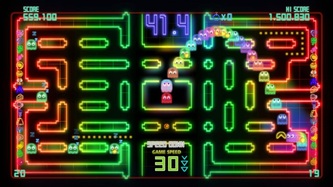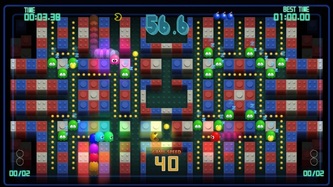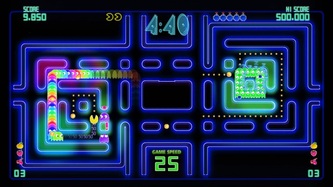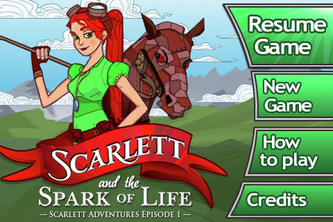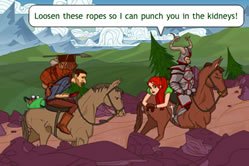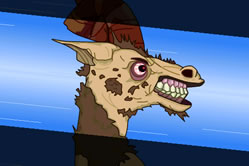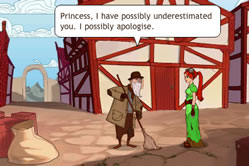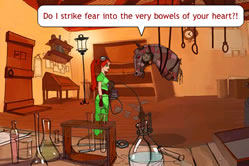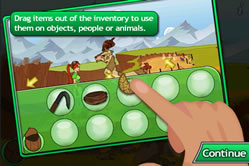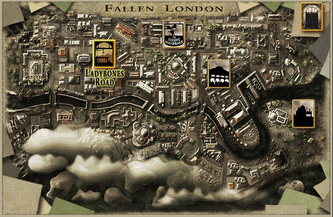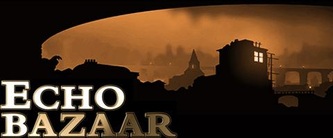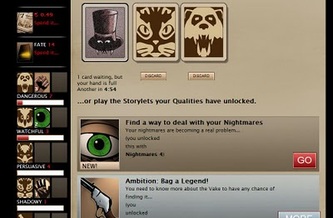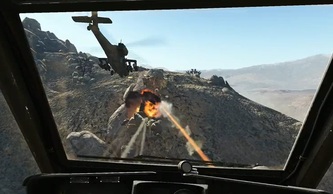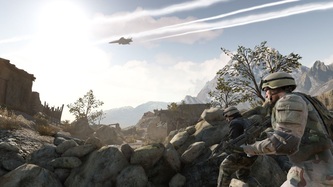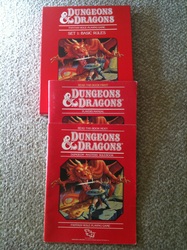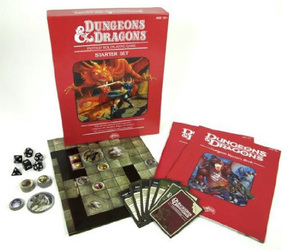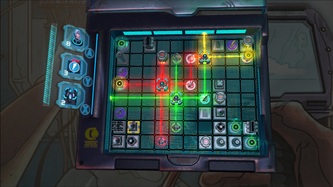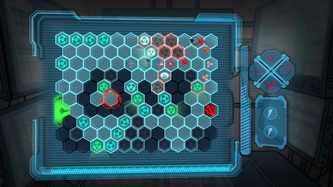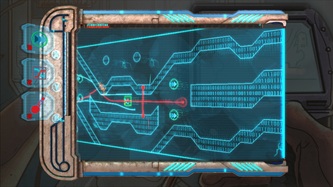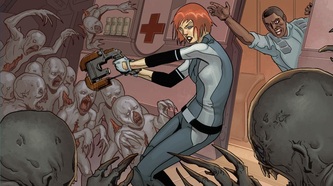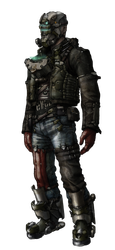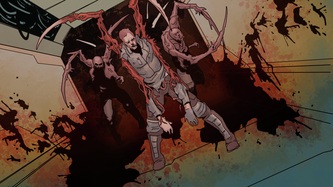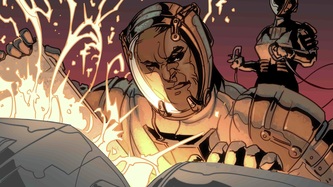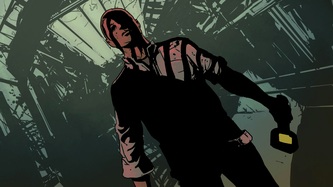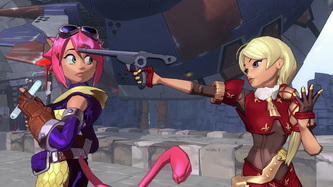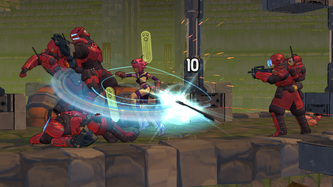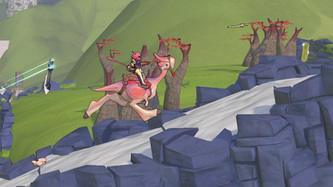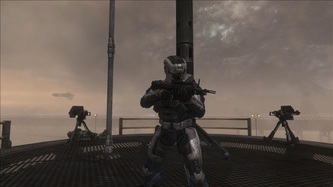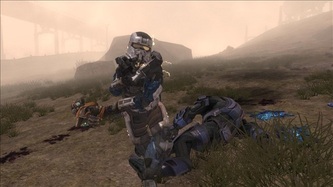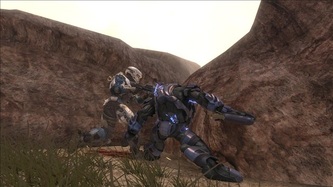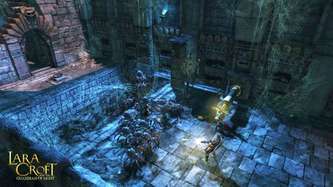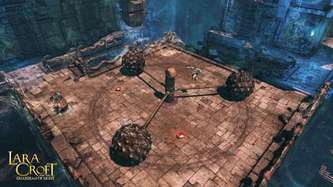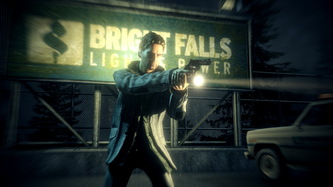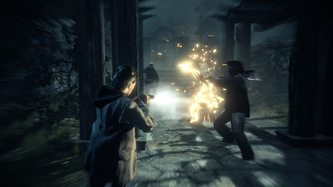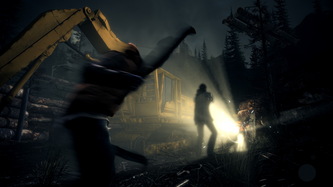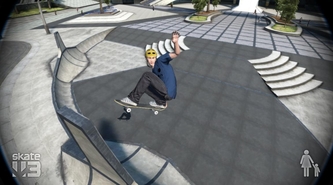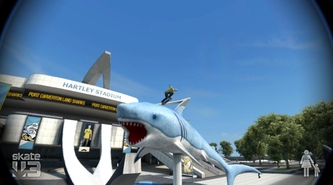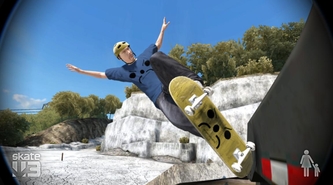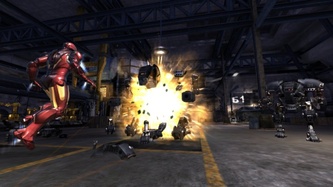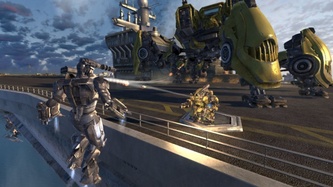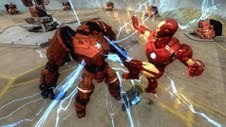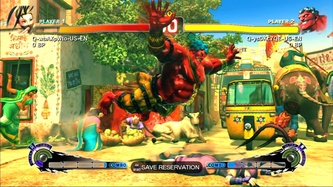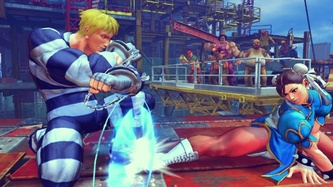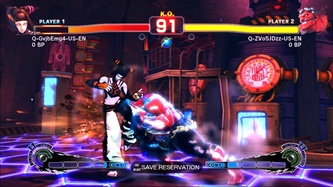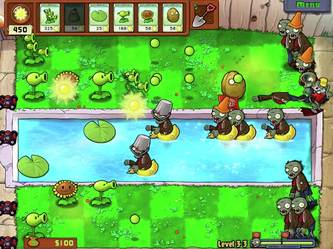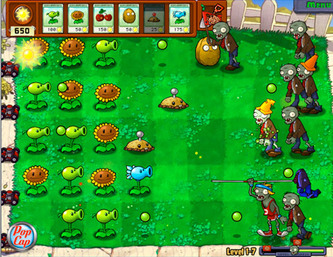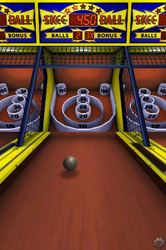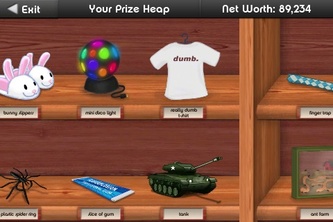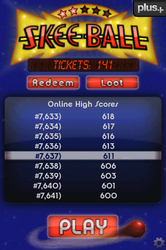2010 GAMES ARCHIVES
12-28-10: Review--Pac-Man Championship Edition: DX (XBLA)
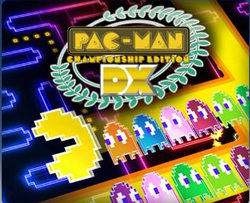
by Brian LeTendre
In 2007, Toru Iwatani, the man behind the original Pac-Man, created an amazing new entry in the franchise called “Pac-Man Championship Edition.” While “Pac-Man C.E.” centered around the same dot-eating mechanic the series was founded on, the game completely re-energized the formula by adding time-limits and changing the way the dots appear on the screen. The game basically became a 5-minute time-attack mode, where you tried to score as many points as possible. It was a successful reinvention of Pac-Man that was well-received by critics and fans alike. “Pac-Man C.E.” was also Iwatani’s last game before he retired.
A couple of weeks ago, Namco released a new iteration of “Pac-Man Championship Edition” called “Pac-Man Championship Edition: DX,” and the game builds on the foundation of its predecssor to create an experience that is completely addiciting, and possibly the best Pac-Man game ever.
“PMCE: DX” takes the time-limited, score as many points as possible formula and tweaks it beautifully. Instead of having four ghosts chasing you around the board, there are several sleeping ghosts that appear on the board at any given time. As soon as Pac-Man passes a ghost, it wakes up and starts chasing him. As Pac-Man clears the sets of dots on the board, more dots and more sleeping ghosts appear. The goal is to have as many ghosts as possible chasing Pac-Man before you eat a power pellet. When you do finally eat that pellet, you set off this amazing chain of bonus points as you chomp through all of the ghosts you’ve gotten to chase you. It’s a thing of beauty.
In addition to the sleeping ghosts, there is also a mechanic where you can use “bombs” to kick ghosts back to their home base. You get a limited number of these, so there is some strategy involved in their use.
These twists on the formula that “PMCE” established make for one of the best arcade experiences ever. I was immediately hooked and became addicted to topping my own personal best score,a s well as some of my friends on the leaderboards. Throw in the new boards you unlock, the great soundtrack, and the ability to customize the look of the game, and “PMCE: DX” is an amazing package that I have no trouble recommending for the $10 price tag.
5 out of 5 Ghost Trains
In 2007, Toru Iwatani, the man behind the original Pac-Man, created an amazing new entry in the franchise called “Pac-Man Championship Edition.” While “Pac-Man C.E.” centered around the same dot-eating mechanic the series was founded on, the game completely re-energized the formula by adding time-limits and changing the way the dots appear on the screen. The game basically became a 5-minute time-attack mode, where you tried to score as many points as possible. It was a successful reinvention of Pac-Man that was well-received by critics and fans alike. “Pac-Man C.E.” was also Iwatani’s last game before he retired.
A couple of weeks ago, Namco released a new iteration of “Pac-Man Championship Edition” called “Pac-Man Championship Edition: DX,” and the game builds on the foundation of its predecssor to create an experience that is completely addiciting, and possibly the best Pac-Man game ever.
“PMCE: DX” takes the time-limited, score as many points as possible formula and tweaks it beautifully. Instead of having four ghosts chasing you around the board, there are several sleeping ghosts that appear on the board at any given time. As soon as Pac-Man passes a ghost, it wakes up and starts chasing him. As Pac-Man clears the sets of dots on the board, more dots and more sleeping ghosts appear. The goal is to have as many ghosts as possible chasing Pac-Man before you eat a power pellet. When you do finally eat that pellet, you set off this amazing chain of bonus points as you chomp through all of the ghosts you’ve gotten to chase you. It’s a thing of beauty.
In addition to the sleeping ghosts, there is also a mechanic where you can use “bombs” to kick ghosts back to their home base. You get a limited number of these, so there is some strategy involved in their use.
These twists on the formula that “PMCE” established make for one of the best arcade experiences ever. I was immediately hooked and became addicted to topping my own personal best score,a s well as some of my friends on the leaderboards. Throw in the new boards you unlock, the great soundtrack, and the ability to customize the look of the game, and “PMCE: DX” is an amazing package that I have no trouble recommending for the $10 price tag.
5 out of 5 Ghost Trains
12-14-10: Review--Scarlett and the Spark of Life (iPhone)
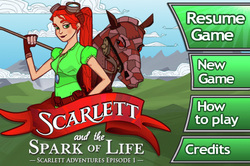
by Brian LeTendre
Since the days of Donkey Kong, one of the most often used tropes in video games is the kidnapped princess. Entire franchises have been built around the concept of the male hero saving the defenseless princess from whatever bad guy is holding her captive. But does it always have to be that way?
The guys over at Launching Pad Games don't think so, and that's just one of the refreshing aspects of their new iPhone game, Scarlet and the Spark of Life: The Scarlet Adventures Episode 1."
"Scarlett and the Spark of Life" is the first in a series of adventure games featuring a princess that would rather save herself than wait around for a knight in shining armor. In this first episode, Scarlett wakes up on the back of a horse, after being drugged and kidnapped. After finding a way to escape, she stumbles into a strange town, where all of the horses have been driven away by feral llama creatures called Polcalcos. In order to get out of town and evade her pursuing kidnappers, Scarlett must build a mechanical horse from materials she gathers from the town and surrounding areas. Along the way she meets some of the very colorful townsfolk, and has to solve puzzles to collect all of the items she needs.
Two minutes into this game, I was hooked. The game looks great with its animated, cartoonish style, but it's the writing that pulls you right in. The dialogue is very well written, and I found myself going back through conversations with some of the townsfolk just to see how all of the variations played out. While the gameplay is certainly a throwback to the point-and-click adventure games of yore, it's much more user-friendly, featuring a simple drag and drop interface, and a hint system that ensures you don't get stuck for too long.
Adventure games are a perfect fit for the iPhone, and "Scarlett and the Spark of Life" is an example of what made that genre so popular in the first place--good writing. I'll be coming back to experience the further adventures of Scarlett in the ensuing episodes.
4 out of 5 Rabid Llamas
Since the days of Donkey Kong, one of the most often used tropes in video games is the kidnapped princess. Entire franchises have been built around the concept of the male hero saving the defenseless princess from whatever bad guy is holding her captive. But does it always have to be that way?
The guys over at Launching Pad Games don't think so, and that's just one of the refreshing aspects of their new iPhone game, Scarlet and the Spark of Life: The Scarlet Adventures Episode 1."
"Scarlett and the Spark of Life" is the first in a series of adventure games featuring a princess that would rather save herself than wait around for a knight in shining armor. In this first episode, Scarlett wakes up on the back of a horse, after being drugged and kidnapped. After finding a way to escape, she stumbles into a strange town, where all of the horses have been driven away by feral llama creatures called Polcalcos. In order to get out of town and evade her pursuing kidnappers, Scarlett must build a mechanical horse from materials she gathers from the town and surrounding areas. Along the way she meets some of the very colorful townsfolk, and has to solve puzzles to collect all of the items she needs.
Two minutes into this game, I was hooked. The game looks great with its animated, cartoonish style, but it's the writing that pulls you right in. The dialogue is very well written, and I found myself going back through conversations with some of the townsfolk just to see how all of the variations played out. While the gameplay is certainly a throwback to the point-and-click adventure games of yore, it's much more user-friendly, featuring a simple drag and drop interface, and a hint system that ensures you don't get stuck for too long.
Adventure games are a perfect fit for the iPhone, and "Scarlett and the Spark of Life" is an example of what made that genre so popular in the first place--good writing. I'll be coming back to experience the further adventures of Scarlett in the ensuing episodes.
4 out of 5 Rabid Llamas
12-2-10: Review--Echo Bazaar (PC)
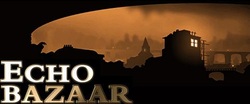
by Max Saltonstall
Coming from FailBetterGames, Echo Bazaar is the story of what happened after Victorian London was taken by bats down below the surface of the earth to reside in an immeasurable underground cavern not far from the shores of Hell.
This web-based narrative RPG spins a masterful setting, and slowly doles out enticing new elements to the player. Choose whatever persona you like and endeavor to escape from prison, make contacts among the Devils of Hell or the Urchins of the streets, and amass a fortune in
rats, glim or (sort of) gold.
I've enjoyed playing this game to explore and discover, and I think any fan of narrative fiction should take a look. If you've ever loved a text-adventure game, choose-your-own-adventure book or Victorian RPG, go log in to Echo Bazaar and escape from New Newgate Prison. I don't think you'll regret it (unless of course you end up having insane nightmares... but that's half the fun).
5 out of 5 Masters of the Bazaar
The game is free to play, and you can check it out here.
Coming from FailBetterGames, Echo Bazaar is the story of what happened after Victorian London was taken by bats down below the surface of the earth to reside in an immeasurable underground cavern not far from the shores of Hell.
This web-based narrative RPG spins a masterful setting, and slowly doles out enticing new elements to the player. Choose whatever persona you like and endeavor to escape from prison, make contacts among the Devils of Hell or the Urchins of the streets, and amass a fortune in
rats, glim or (sort of) gold.
I've enjoyed playing this game to explore and discover, and I think any fan of narrative fiction should take a look. If you've ever loved a text-adventure game, choose-your-own-adventure book or Victorian RPG, go log in to Echo Bazaar and escape from New Newgate Prison. I don't think you'll regret it (unless of course you end up having insane nightmares... but that's half the fun).
5 out of 5 Masters of the Bazaar
The game is free to play, and you can check it out here.
11-15-10: Review--Medal of Honor (PS3)
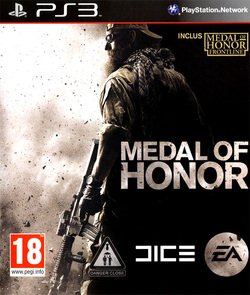
by Brian LeTendre
The latest entry in EA's "Medal of Honor" series takes the franchise into the modern era, as opposed to the World War II setting of the previous games. The single player campaign in “Medal of Honor” is an enjoyable one, punctuated by some epic moments, while the multiplayer doesn't really hold up when compared to some of its contemporaries.
"MoH's" single player campaign is set in 2002, during the invasion of Afghanistan. You take on the role of Naval Special Warfare operatives, Delta Force members and Army Rangers as you progress through a story that begins with a recon mission and evolves into a rescue operation, with a whole lot of firefights along the way. The campaign is very scripted and linear, which isn't necessarily a bad thing. The devs have a story to tell and they funnel you through that story, sometimes taking control from you in order to show you something cool or punctuate a big moment. There are some big moments, too. There are some very tense firefights that end in dramatic moments, and a few of them are were something I had not experienced in a shooter before. For example, there's a point at which you and your squadmates are holed up in s small building that is literally being blown apart. You start running low on ammo, you cover gets destroyed, and there is a growing sense that you will be overwhelmed at any moment. Scripted as it may have been, the whole battle played out brilliantly, and it's a gaming moment I won't soon forget. The whole campaign was an entertaining ride, and it was capped off with a nice message from the devs to our armed forces who are currently out there fighting for us around the world.
On the multiplayer front, it's a bit of a different story. I was really excited that DICE was developing the multiplayer for “MoH,” based on their stellar Battlefield: Bad Company 2, which I love. Sadly though, this felt a bit rushed, and the end result is something that just doesn't stand out from the other shooters that are out there. The maps feel unbalanced, the classes don't feel different from one another, and the spawn system has problems. Getting spawn-killed or sniped from across the map before you can make it out of your base is a common occurrence, which makes for a very frustrating time. On the plus side, the game looks great, the weapons themselves felt good, and the unlock system does provide a good reason to stick with the multiplayer, even if you get off to a rough start. When you look around at some of the other shooters out there, like the PS3-exclusive "MAG" or "Bad Company 2," it's clear there are better options than "MoH," and that's not even taking into account the just-released "Call of Duty: Black Ops."
So, if you are looking for an entertaining single-player campaign, there's a lot to like with “Medal of Honor.” While the multiplayer is serviceable, it's not a reason to purchase the game, so you may just want to wait for the inevitable price drop before you grab this for the campaign.
3.5 out of 5 Tiers
The latest entry in EA's "Medal of Honor" series takes the franchise into the modern era, as opposed to the World War II setting of the previous games. The single player campaign in “Medal of Honor” is an enjoyable one, punctuated by some epic moments, while the multiplayer doesn't really hold up when compared to some of its contemporaries.
"MoH's" single player campaign is set in 2002, during the invasion of Afghanistan. You take on the role of Naval Special Warfare operatives, Delta Force members and Army Rangers as you progress through a story that begins with a recon mission and evolves into a rescue operation, with a whole lot of firefights along the way. The campaign is very scripted and linear, which isn't necessarily a bad thing. The devs have a story to tell and they funnel you through that story, sometimes taking control from you in order to show you something cool or punctuate a big moment. There are some big moments, too. There are some very tense firefights that end in dramatic moments, and a few of them are were something I had not experienced in a shooter before. For example, there's a point at which you and your squadmates are holed up in s small building that is literally being blown apart. You start running low on ammo, you cover gets destroyed, and there is a growing sense that you will be overwhelmed at any moment. Scripted as it may have been, the whole battle played out brilliantly, and it's a gaming moment I won't soon forget. The whole campaign was an entertaining ride, and it was capped off with a nice message from the devs to our armed forces who are currently out there fighting for us around the world.
On the multiplayer front, it's a bit of a different story. I was really excited that DICE was developing the multiplayer for “MoH,” based on their stellar Battlefield: Bad Company 2, which I love. Sadly though, this felt a bit rushed, and the end result is something that just doesn't stand out from the other shooters that are out there. The maps feel unbalanced, the classes don't feel different from one another, and the spawn system has problems. Getting spawn-killed or sniped from across the map before you can make it out of your base is a common occurrence, which makes for a very frustrating time. On the plus side, the game looks great, the weapons themselves felt good, and the unlock system does provide a good reason to stick with the multiplayer, even if you get off to a rough start. When you look around at some of the other shooters out there, like the PS3-exclusive "MAG" or "Bad Company 2," it's clear there are better options than "MoH," and that's not even taking into account the just-released "Call of Duty: Black Ops."
So, if you are looking for an entertaining single-player campaign, there's a lot to like with “Medal of Honor.” While the multiplayer is serviceable, it's not a reason to purchase the game, so you may just want to wait for the inevitable price drop before you grab this for the campaign.
3.5 out of 5 Tiers
11-11-10: Review--Dungeons & Dragons Starter Set
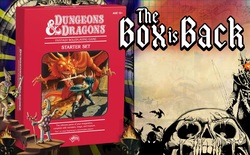
by Brian LeTendre
What a disappointment.
It's tough for me to write this, as I had such high hopes for the new version of the D&D Starter Set. This new version of the original "Red Box" evoked memories of the box that started it all for me and made me a lifelong fan of D&D. Sadly, this new box is a pitiful shadow of its predecessor, one which I cannot recommend to anyone.
For the uninitiated, the "Red Box" I'm referring to was the 1983 version of the D&D rules, referred to as the "Basic Set." (NOTE: There are different versions of this set dating back to 1977, but the new set is based on this 1983 one). The box contained a 64-page Player's book, a 48-page Dungeon Master's book, six dice and a crayon. It retailed for $19.99, but I bought it off of a classmate's brother for ten bucks (a whole lot of allowance at the time). That box changed my life, and the first time I read through the Player's book is one of the fondest memories from my childhood.
My nerdiness aside, the original Basic Rules were great for a couple of reasons. For starters, the Player's book introduced you to the game via a "Choose Your Own Adventure"-style scenario. As you read through, the basic rules and game concepts were spoon fed to you, and by the time you had finished the adventure, you had a pretty good idea of what the game was about. The Player's book also contained all the info you needed to create a character, equip him or her, and progress up to 3rd level. The accompanying Dungeon Master's book taught players how to run the game, and gave tips on creating new adventures, as well as info on monsters and treasure to fill those adventures with.
All in all, the original Basic Rules gave you everything you needed to play. Those who wanted to move past level three could go buy the Expert Rules (blue box), and those who were looking for a more complex game could try Advanced Dungeons and Dragons. But the Basic Rules gave you plenty to play with, and the product could stand on its own.
The new Red Box, titled the "Starter Set," is no such animal, although it bears certain similarities to the original Red Box (most notably, the red box). The "Starter Set" is part of the new "Essentials" line of D&D, which, like the Basic Rules of yore, is designed to get new players into D&D by streamlining some of the more advanced rules of the 4th Edition. Howsoever, this "Starter Set" is really just a series of encounters strung together that introduce the rules of the game. It has none of the pieces that the original did that would allow it to be a standalone product. While the Player's book features a solo adventure, there's no character creation rules, no equipment lists--nothing that you can come back to as a rulebook. The Dungeon Master's book is pretty much the same--it has more encounters to run players through, and it focuses on helping DMs create and run encounters. But there's no bestiary, no treasure table, nothing to come back to. The product can't stand on its own, and you'll have to go pick up other books in the "Essentials" line in order to run even low-level adventures.
My biggest gripe about the new "Starter Set" however, is the quality. It's terrible. The books are flimsy, consisting of glossy paper without even a cardstock covers--they're basically brochures. I pulled out my 1983 Basic Rules while I was writing this review, and that sucker is sturdy. Heavy paper, cardstock covers--even the box is sturdy. There is no way this new version will be sitting on my bookshelf almost thirty years from now. I can't imagine it lasting more than ten or so play sessions before the booklets are falling apart.
As I said at the top, this is a really disappointing product. It may ignite your nostalgia for D&D at first glance, but you would be much better served heading over to eBay and buying the original "Basic Rules," which you get for about $15, as they are a much better way to introduce your kids to roleplaying games.
1 out of 5 Heartbreakers
What a disappointment.
It's tough for me to write this, as I had such high hopes for the new version of the D&D Starter Set. This new version of the original "Red Box" evoked memories of the box that started it all for me and made me a lifelong fan of D&D. Sadly, this new box is a pitiful shadow of its predecessor, one which I cannot recommend to anyone.
For the uninitiated, the "Red Box" I'm referring to was the 1983 version of the D&D rules, referred to as the "Basic Set." (NOTE: There are different versions of this set dating back to 1977, but the new set is based on this 1983 one). The box contained a 64-page Player's book, a 48-page Dungeon Master's book, six dice and a crayon. It retailed for $19.99, but I bought it off of a classmate's brother for ten bucks (a whole lot of allowance at the time). That box changed my life, and the first time I read through the Player's book is one of the fondest memories from my childhood.
My nerdiness aside, the original Basic Rules were great for a couple of reasons. For starters, the Player's book introduced you to the game via a "Choose Your Own Adventure"-style scenario. As you read through, the basic rules and game concepts were spoon fed to you, and by the time you had finished the adventure, you had a pretty good idea of what the game was about. The Player's book also contained all the info you needed to create a character, equip him or her, and progress up to 3rd level. The accompanying Dungeon Master's book taught players how to run the game, and gave tips on creating new adventures, as well as info on monsters and treasure to fill those adventures with.
All in all, the original Basic Rules gave you everything you needed to play. Those who wanted to move past level three could go buy the Expert Rules (blue box), and those who were looking for a more complex game could try Advanced Dungeons and Dragons. But the Basic Rules gave you plenty to play with, and the product could stand on its own.
The new Red Box, titled the "Starter Set," is no such animal, although it bears certain similarities to the original Red Box (most notably, the red box). The "Starter Set" is part of the new "Essentials" line of D&D, which, like the Basic Rules of yore, is designed to get new players into D&D by streamlining some of the more advanced rules of the 4th Edition. Howsoever, this "Starter Set" is really just a series of encounters strung together that introduce the rules of the game. It has none of the pieces that the original did that would allow it to be a standalone product. While the Player's book features a solo adventure, there's no character creation rules, no equipment lists--nothing that you can come back to as a rulebook. The Dungeon Master's book is pretty much the same--it has more encounters to run players through, and it focuses on helping DMs create and run encounters. But there's no bestiary, no treasure table, nothing to come back to. The product can't stand on its own, and you'll have to go pick up other books in the "Essentials" line in order to run even low-level adventures.
My biggest gripe about the new "Starter Set" however, is the quality. It's terrible. The books are flimsy, consisting of glossy paper without even a cardstock covers--they're basically brochures. I pulled out my 1983 Basic Rules while I was writing this review, and that sucker is sturdy. Heavy paper, cardstock covers--even the box is sturdy. There is no way this new version will be sitting on my bookshelf almost thirty years from now. I can't imagine it lasting more than ten or so play sessions before the booklets are falling apart.
As I said at the top, this is a really disappointing product. It may ignite your nostalgia for D&D at first glance, but you would be much better served heading over to eBay and buying the original "Basic Rules," which you get for about $15, as they are a much better way to introduce your kids to roleplaying games.
1 out of 5 Heartbreakers
10-28-10: Review--Dead Space Ignition (XBLA)
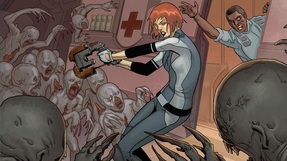
by Brian LeTendre
One of the things I have loved the most about EA's Dead Space franchise is that the vision behind it has always been bigger than just video games. With the first Dead Space game came a great comic series (by Antony Johnston and Ben Templesmith), an animated movie and an alternate reality game, all of which provided some great insight into the events of Dead Space and the larger universe that game takes place in. 2009’s “Dead Space: Extraction” was written by Antony Johnston and was accompanied by another comic from him and Templesmith. The game was criminally under-appreciated on the Wii, but luckily will be re-released (with PlayStation Move support) along with the PS3 version of “Dead Space 2.” With “Dead Space 2” arriving this coming January, EA is once again using multiple mediums to expand the universe. “Dead Space: Martyr” is the recently released first novel set in the universe, and a new comic and animated movie are on the way.
After playing a fantastic demo of “Dead Space 2” at New York Comic Con however, January became much too long to wait for—I needed another Dead Space fix ASAP. Enter “Dead Space: Ignition,” a downloadable game that is part “Choose Your Own Adventure” motion comic and part puzzle game collection. Those that preorder “Dead Space 2” get the game for free, while others can purchase the game for five bucks on either the PlayStation Network or Xbox Live.
The story in “Ignition” is written by Antony Johnston and takes place on the Sprawl, a huge space city that is the setting for “Dead Space 2.” Players take on the role of Franco Dellile, a technician working on the Sprawl who has to deal with several malfunctions that are occurring around the city. Franco is accompanied by his girlfriend Sarah, a security officer that tags along with him because some strange things have been going on in the Sprawl as of late. Of course, things get a lot worse as the next few hours pass. Being a huge fan of the Dead Space universe, I loved seeing different parts of the Sprawl and getting a look into the events that lead up to “Dead Space 2.” The game also offers branching paths at certain points, and based on your choices you can experience four different versions of the story.
The story segments of the game are broken up by three different puzzle minigames that represent Franco hacking into the Sprawl’s systems—Hardware Crack, System Override and Trace Route. Hardware Crack is easily the best of the three games, and it involves redirecting laser beams to different circuits by positioning mirrors and splitters in strategic places. System Override is a tower defense minigame that doesn’t require strategy so much as spammed attacks to beat. Trace Route is kind of like a racing game, but the floaty controls and overly aggressive AI made it the one game I had to repeat over and over in order to move the story forward, which was pretty frustrating.
Overall the minigames are the weakest part about “Ignition,” and I almost wish that EA had released it as just a motion comic with branching story paths. For Dead Space fans, the “Ignition” adds another layer to the fiction of the universe, and there are unlockable items for “Dead Space 2” (a new suit, weapon skin, audio logs, and upgrade items) that offer some good reasons to play through the game. However, if you didn’t preorder, I can’t recommend spending five bucks on it.
3 out of 5 Unitologists
One of the things I have loved the most about EA's Dead Space franchise is that the vision behind it has always been bigger than just video games. With the first Dead Space game came a great comic series (by Antony Johnston and Ben Templesmith), an animated movie and an alternate reality game, all of which provided some great insight into the events of Dead Space and the larger universe that game takes place in. 2009’s “Dead Space: Extraction” was written by Antony Johnston and was accompanied by another comic from him and Templesmith. The game was criminally under-appreciated on the Wii, but luckily will be re-released (with PlayStation Move support) along with the PS3 version of “Dead Space 2.” With “Dead Space 2” arriving this coming January, EA is once again using multiple mediums to expand the universe. “Dead Space: Martyr” is the recently released first novel set in the universe, and a new comic and animated movie are on the way.
After playing a fantastic demo of “Dead Space 2” at New York Comic Con however, January became much too long to wait for—I needed another Dead Space fix ASAP. Enter “Dead Space: Ignition,” a downloadable game that is part “Choose Your Own Adventure” motion comic and part puzzle game collection. Those that preorder “Dead Space 2” get the game for free, while others can purchase the game for five bucks on either the PlayStation Network or Xbox Live.
The story in “Ignition” is written by Antony Johnston and takes place on the Sprawl, a huge space city that is the setting for “Dead Space 2.” Players take on the role of Franco Dellile, a technician working on the Sprawl who has to deal with several malfunctions that are occurring around the city. Franco is accompanied by his girlfriend Sarah, a security officer that tags along with him because some strange things have been going on in the Sprawl as of late. Of course, things get a lot worse as the next few hours pass. Being a huge fan of the Dead Space universe, I loved seeing different parts of the Sprawl and getting a look into the events that lead up to “Dead Space 2.” The game also offers branching paths at certain points, and based on your choices you can experience four different versions of the story.
The story segments of the game are broken up by three different puzzle minigames that represent Franco hacking into the Sprawl’s systems—Hardware Crack, System Override and Trace Route. Hardware Crack is easily the best of the three games, and it involves redirecting laser beams to different circuits by positioning mirrors and splitters in strategic places. System Override is a tower defense minigame that doesn’t require strategy so much as spammed attacks to beat. Trace Route is kind of like a racing game, but the floaty controls and overly aggressive AI made it the one game I had to repeat over and over in order to move the story forward, which was pretty frustrating.
Overall the minigames are the weakest part about “Ignition,” and I almost wish that EA had released it as just a motion comic with branching story paths. For Dead Space fans, the “Ignition” adds another layer to the fiction of the universe, and there are unlockable items for “Dead Space 2” (a new suit, weapon skin, audio logs, and upgrade items) that offer some good reasons to play through the game. However, if you didn’t preorder, I can’t recommend spending five bucks on it.
3 out of 5 Unitologists
10-14-10: Review--Blade Kitten (PS3)

by Brian LeTendre
For those unfamiliar with the property, "Blade Kitten" actually started out as a series of comics. The series was created by Krome Studios' Creative Director Steve Stamatiadis, as he wanted to flesh out an idea that he had for a game. "Blade Kitten" revolves around main character Kit Ballard, who is a feline/human hybrid that's the last of her race (the Felions). She makes her living as a bounty hunter, chasing bad guys around the universe.
The "Blade Kitten" game is actually a prequel of sorts to the comic, taking place on a planet called Hollow Wish, where Kit has tracked down her latest bounty. Once she's planet side, another hunter shows up and (her arch rival Justice Kreel) tries to steal the bounty away from Kit. As Kit heads off in pursuit of the other hunter, she has to fight her way through the minions of the criminal she came there to catch in the first place. To take on the bad guys, Kit is armed with the Darque Blade, a hovering sword that responds to Kit's thoughts. She also has a pet sidekick named Skiffy that can get into places Kit would never be able to. As Kit pursues her bounty, she starts to figure out that there's something else going on in Hollow Wish that's much bigger than a bounty hunting job.
The story in "Blade Kitten" is presented though a series of in-game cut scenes, and both the art and voice acting are well done. The game upholds the look of the characters and universe that was established in the comics, and Kit's wise-cracking personality makes the transition from comic to game well.
As far as the general gameplay, "Blade Kitten" is a side-scrolling platformer/brawler. What sets it apart from most games in the genre is that Kit can climb just about any surface she can touch, so she can scale up walls and shimmy across ceilings with ease. The levels are pretty linear, so most of the time there is only one main path to head down, but there's a lot of hidden items and currency that Kit can find if you can figure out how to traverse a certain area to get to it. You can use that currency to purchase better blades and different outfits for Kit, as well as some consumable power-ups, so there's good reason to go looking around for loot while you're beating up the bad guys. For the most part, the combat and platforming both work well, although the controls are a little floaty, so it took me a little while to get used to it. Because Kit's sword is floating as opposed to being held by her, there is an element of timing to the combat. kit can actually send her sword on a ranged attack, and if you time that incorrectly, you're left momentarily vulnerable. Kit also has a sort of force shield she can employ, but it's energy is limited, so timing is important there as well. Once the rhythm of the combat system clicked with me, I had a lot of fun wiping out wave after wave of enemies. There are also levels where Kit gets to ride a dinosaur-type creature through the countryside, smashing through barriers and then dismounting to take on enemies at different outposts. While these levels provide a slight change of pace, the nature of the gameplay doesn't change much over the course of the game.
Blade Kitten is a fun, arcade-style action game that offers a nice dose of nostalgia as well as an interesting world and characters. While the gameplay can get repetitive, it's never boring, and the ability to upgrade weapons and unlock new outfits for Kit adds some re-playability to the game. I enjoyed the game, and I'm looking forward to the second episode, which is already in development.
3.5 out of 5 Psychic Swords
For those looking to learn more about the universe of "Blade Kitten," you can read all of the comics over on www.bladekitten.com. You can also read the interview I did with creator Steve Stamatiadis for Comic Book Resources here.
For those unfamiliar with the property, "Blade Kitten" actually started out as a series of comics. The series was created by Krome Studios' Creative Director Steve Stamatiadis, as he wanted to flesh out an idea that he had for a game. "Blade Kitten" revolves around main character Kit Ballard, who is a feline/human hybrid that's the last of her race (the Felions). She makes her living as a bounty hunter, chasing bad guys around the universe.
The "Blade Kitten" game is actually a prequel of sorts to the comic, taking place on a planet called Hollow Wish, where Kit has tracked down her latest bounty. Once she's planet side, another hunter shows up and (her arch rival Justice Kreel) tries to steal the bounty away from Kit. As Kit heads off in pursuit of the other hunter, she has to fight her way through the minions of the criminal she came there to catch in the first place. To take on the bad guys, Kit is armed with the Darque Blade, a hovering sword that responds to Kit's thoughts. She also has a pet sidekick named Skiffy that can get into places Kit would never be able to. As Kit pursues her bounty, she starts to figure out that there's something else going on in Hollow Wish that's much bigger than a bounty hunting job.
The story in "Blade Kitten" is presented though a series of in-game cut scenes, and both the art and voice acting are well done. The game upholds the look of the characters and universe that was established in the comics, and Kit's wise-cracking personality makes the transition from comic to game well.
As far as the general gameplay, "Blade Kitten" is a side-scrolling platformer/brawler. What sets it apart from most games in the genre is that Kit can climb just about any surface she can touch, so she can scale up walls and shimmy across ceilings with ease. The levels are pretty linear, so most of the time there is only one main path to head down, but there's a lot of hidden items and currency that Kit can find if you can figure out how to traverse a certain area to get to it. You can use that currency to purchase better blades and different outfits for Kit, as well as some consumable power-ups, so there's good reason to go looking around for loot while you're beating up the bad guys. For the most part, the combat and platforming both work well, although the controls are a little floaty, so it took me a little while to get used to it. Because Kit's sword is floating as opposed to being held by her, there is an element of timing to the combat. kit can actually send her sword on a ranged attack, and if you time that incorrectly, you're left momentarily vulnerable. Kit also has a sort of force shield she can employ, but it's energy is limited, so timing is important there as well. Once the rhythm of the combat system clicked with me, I had a lot of fun wiping out wave after wave of enemies. There are also levels where Kit gets to ride a dinosaur-type creature through the countryside, smashing through barriers and then dismounting to take on enemies at different outposts. While these levels provide a slight change of pace, the nature of the gameplay doesn't change much over the course of the game.
Blade Kitten is a fun, arcade-style action game that offers a nice dose of nostalgia as well as an interesting world and characters. While the gameplay can get repetitive, it's never boring, and the ability to upgrade weapons and unlock new outfits for Kit adds some re-playability to the game. I enjoyed the game, and I'm looking forward to the second episode, which is already in development.
3.5 out of 5 Psychic Swords
For those looking to learn more about the universe of "Blade Kitten," you can read all of the comics over on www.bladekitten.com. You can also read the interview I did with creator Steve Stamatiadis for Comic Book Resources here.
9-18-10: Review--Halo: Reach (XBox 360)
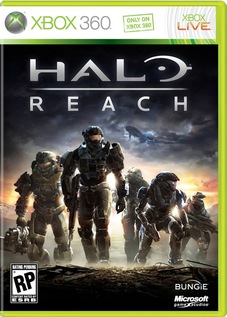
by Brian LeTendre
"Halo: Reach" is one of those rare sequels that manages to not only fix the problems of previous games in the series, but take the best of everything that came before and combine it into a very polished and robust experience. It's a fitting swansong for Bungie's involvement with the franchise.
Having played all of the previous games in the series, I should start by saying I've had a bit of a love/hate relationship with Halo over the years. I have always really enjoyed the single player (and more recently co-op) campaigns in the Halo games, but I have had a lot less fun with Halo's competitive multiplayer components.
My dislike of Halo's multiplayer really just comes down to the fact that I've never really been able to get comfortable or good at it, which makes for a lousy experience. What surprised me the most about “Halo: Reach” was that in addition to the great campaign, the changes Bungie made to multiplayer have made it something I will actually spend a lot of time playing in the future.
The meat of the game for me is still the campaign however, and boy does "Halo: Reach" have a great one. The storyline goes back to the roots of the series, and the fabled decimation of the planet Reach that happened prior to the original Halo. You get to experience the last days of Reach through the eyes of 6, a Spartan soldier that's a member of the elite Noble Team. Noble team discovers that the Covenant forces have arrived on Reach, and then have to help defend the planet from a full-on invasion. Along the way they discover something that may turn the tide of the war for humanity.
To Bungie's credit, they do a fantastic job of building tension and creating a sense of unknown in a storyline where you basically know the ending. I found it to be the most atmospheric of the Halo games, combining the soaring elements of the first three games with the darker, more serious tone of "ODST." More so than any of the previous games, Reach offers a lot of variety, from the changing terrain and environments, to the team members that accompany you, to the soundtrack itself. Bungie clearly understood the wealth of material that had been created in previous games, and they pull from all of that material in “Reach.” Early in the game for example, I found myself battling covenant forces through a military installation. The battle felt very much like the first firefight in the original Halo, right down to the appearance of the rooms and corridors. That type of experience happens throughout the game, and it never feels like an experience is being re-used, it just feels like a great nod to all that you've seen in the other games.
The theme of combining the best elements of the series translates to the gameplay as well. The power-ups that used to be picked up around the battlefield for single-use are now components you can incorporate into your armor. These components will allow you to do things like sprint, use a jetpack, create a hologram of yourself to fool enemies, and camouflage yourself for limited periods of time. You can swap out your armor power-up when you find a different one, and I found myself switching armor components almost as much as I switch weapons. In addition to the armor abilities, there are other new additions to the gameplay, and the biggest is aerial space combat. I won't spoil the details, except to say that it's very satisfying and very fun.
So the campaign is pretty much great from top to bottom, and “Halo: Reach” would be well worth a purchase for me even if I never touched the multiplayer. So far however, I've really had fun with the multiplayer in “Reach.” There's plenty of modes, from the standard Slayer (deathmatch) to the Firefight (fighting waves of enemies) mode from “ODST,” Probably my favorite addition is the new Headhunter mode, in which a player drops a skull when killed that another player can collect and drop off at a designated location to score points. Players can be carrying multiple skulls at a time, so if they get killed before reaching the scoring area, all of the skulls drop for another player to snatch up. Bungie has also gone the extra mile to improve the social experience for players, as evidenced by the “social settings,” which are an additional set of matchmaking filters to help ensure you get to play with the type of people you want (the non-trash talking type, for example). There's also a new credit system, where you earn credits for playing the game that can be spent on items to customize your armor. Bungie issues daily challenges related to multiplayer that will earn you additional credits of you complete them, giving players another reason to tune in on a regular basis. Throw in the Forge, where players can create their own maps, and the film and screenshot making tools, and “Halo Reach's” multiplayer is more robust than anything else out there right now.
“Halo: Reach” is not only a worthy goodbye to the series for Bungie, but it's also a shining example of what a complete gaming experience on a console should be. There is something for everyone in “Halo: Reach,” and I suspect it will be the new bar that shooters are measured against for the remainder of the Xbox 360's life cycle.
5 out of 5 Going Out On Tops
"Halo: Reach" is one of those rare sequels that manages to not only fix the problems of previous games in the series, but take the best of everything that came before and combine it into a very polished and robust experience. It's a fitting swansong for Bungie's involvement with the franchise.
Having played all of the previous games in the series, I should start by saying I've had a bit of a love/hate relationship with Halo over the years. I have always really enjoyed the single player (and more recently co-op) campaigns in the Halo games, but I have had a lot less fun with Halo's competitive multiplayer components.
My dislike of Halo's multiplayer really just comes down to the fact that I've never really been able to get comfortable or good at it, which makes for a lousy experience. What surprised me the most about “Halo: Reach” was that in addition to the great campaign, the changes Bungie made to multiplayer have made it something I will actually spend a lot of time playing in the future.
The meat of the game for me is still the campaign however, and boy does "Halo: Reach" have a great one. The storyline goes back to the roots of the series, and the fabled decimation of the planet Reach that happened prior to the original Halo. You get to experience the last days of Reach through the eyes of 6, a Spartan soldier that's a member of the elite Noble Team. Noble team discovers that the Covenant forces have arrived on Reach, and then have to help defend the planet from a full-on invasion. Along the way they discover something that may turn the tide of the war for humanity.
To Bungie's credit, they do a fantastic job of building tension and creating a sense of unknown in a storyline where you basically know the ending. I found it to be the most atmospheric of the Halo games, combining the soaring elements of the first three games with the darker, more serious tone of "ODST." More so than any of the previous games, Reach offers a lot of variety, from the changing terrain and environments, to the team members that accompany you, to the soundtrack itself. Bungie clearly understood the wealth of material that had been created in previous games, and they pull from all of that material in “Reach.” Early in the game for example, I found myself battling covenant forces through a military installation. The battle felt very much like the first firefight in the original Halo, right down to the appearance of the rooms and corridors. That type of experience happens throughout the game, and it never feels like an experience is being re-used, it just feels like a great nod to all that you've seen in the other games.
The theme of combining the best elements of the series translates to the gameplay as well. The power-ups that used to be picked up around the battlefield for single-use are now components you can incorporate into your armor. These components will allow you to do things like sprint, use a jetpack, create a hologram of yourself to fool enemies, and camouflage yourself for limited periods of time. You can swap out your armor power-up when you find a different one, and I found myself switching armor components almost as much as I switch weapons. In addition to the armor abilities, there are other new additions to the gameplay, and the biggest is aerial space combat. I won't spoil the details, except to say that it's very satisfying and very fun.
So the campaign is pretty much great from top to bottom, and “Halo: Reach” would be well worth a purchase for me even if I never touched the multiplayer. So far however, I've really had fun with the multiplayer in “Reach.” There's plenty of modes, from the standard Slayer (deathmatch) to the Firefight (fighting waves of enemies) mode from “ODST,” Probably my favorite addition is the new Headhunter mode, in which a player drops a skull when killed that another player can collect and drop off at a designated location to score points. Players can be carrying multiple skulls at a time, so if they get killed before reaching the scoring area, all of the skulls drop for another player to snatch up. Bungie has also gone the extra mile to improve the social experience for players, as evidenced by the “social settings,” which are an additional set of matchmaking filters to help ensure you get to play with the type of people you want (the non-trash talking type, for example). There's also a new credit system, where you earn credits for playing the game that can be spent on items to customize your armor. Bungie issues daily challenges related to multiplayer that will earn you additional credits of you complete them, giving players another reason to tune in on a regular basis. Throw in the Forge, where players can create their own maps, and the film and screenshot making tools, and “Halo Reach's” multiplayer is more robust than anything else out there right now.
“Halo: Reach” is not only a worthy goodbye to the series for Bungie, but it's also a shining example of what a complete gaming experience on a console should be. There is something for everyone in “Halo: Reach,” and I suspect it will be the new bar that shooters are measured against for the remainder of the Xbox 360's life cycle.
5 out of 5 Going Out On Tops
8-20-10: Review--Lara Croft And The Guardian Of Light (XBLA)
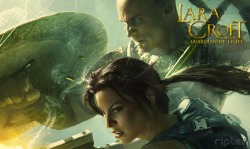
by Brian LeTendre
“Lara Croft and the Guardian of Light” is an excellent game that provides a nice departure from previous entries in the Tomb Raider series, while still remaining true to the elements that made the franchise so popular in the first place.
The story in “Lara Croft and the Guardian of Light” involves a relic-hunting job gone bad. Lara travels with to the fabled Temple of Light to retrieve an artifact called the Mirror of Smoke. A group of mercenaries interfere and steal the Mirror of Smoke, unwittingly releasing an evil being called Xolotl that had been imprisoned within it. As Xolotl takes the Mirror and escaped into the world the guardian of the temple, a warrior called Totec, returns to life. He enlists Lara's aid to find Xolotl and return him to his prison, a chase which leads them into the bowels of the earth. The story isn't terribly deep, but it's a nice setup for why the focus of this game is not as much on exploration, but on finding the bad guy as soon as possible.
While the game does feature offline co-op right now, I played the single-player campaign. The story is largely the same, only Lara and Totec split up to go after Xolotl, and Totec gives Lara his spear, which she can use as both a weapon and a stepladder when needed.
The isometric viewpoint and the focus on fast-paced action are probably the two places where this game differs most from traditional “Tomb Raider” games. Anyone who's played “Baldur's Gate” or will feel right at home with the viewpoint in “Guardian of Light.” The top-down view creates a sense of depth in the game world, and you'll often see the areas you've been to and the areas you're going to in the distance when running through a level. The visuals are gorgeous, from the variety of terrain to the water, fire and explosive effects.
And speaking of running, you'll be doing it—a lot. In addition to the time-based rewards that emphasize completing a level quickly, there are a variety of enemies that will keep you moving through at a brisk pace. Lara faces off against everything from skeleton warriors to giant spiders to packs of crocodiles, and different enemies have different weaknesses, forcing you to switch weapons on the fly. Some of the bosses are gigantic, and one is very reminiscent of the first “Tomb Raider” game. There are also boss battles that feature giant traps and puzzles, as opposed to creatures Lara has to kill. Throughout the game, the combat, platforming and puzzle-solving are juggled really well—the gameplay changes before you ever have a chance to get bored. The combat and platforming mechanics are excellent, and the game has a “Prince of Persia” flow to it at times, where you are grappling, jumping climbing and rolling in succession to avoid traps or enemies. Weapons are mapped to the directional pad, making it easy to switch between them quickly. You can also upgrade weapons with artifacts that you find by completing optional challenges throughout the game.
Everything about this game just works well together, from the great checkpoint system, to the visuals, to the general pace of gameplay. There's a lot of replayability in “Guardian of Light” as well, since each level has several different challenges that you are unlikely to complete the first time through. You can compare your score with everyone on the leaderboards, and reaching certain milestones will reward you with in-game weapons and power-ups.
The only thing the Xbox 360 version of the game doesn't have right now is online co-op, which will arrive in a free update in late September. Don't let that stop you from getting this game now however, as you won't be sick of playing through these levels by the time an online friend can jump in. Plus, you can always invite a friend over for offline co-op is you don't want to brave the game alone.
I am really impressed with “Lara Croft and the Guardian of Light,” and it's easily worth the $15 price. Whether you're a fan of the “Tomb Raider” franchise or not, you'll have a blast with this one.
4.5 out of 5 Adventures Worth Embarking Upon
“Lara Croft and the Guardian of Light” is an excellent game that provides a nice departure from previous entries in the Tomb Raider series, while still remaining true to the elements that made the franchise so popular in the first place.
The story in “Lara Croft and the Guardian of Light” involves a relic-hunting job gone bad. Lara travels with to the fabled Temple of Light to retrieve an artifact called the Mirror of Smoke. A group of mercenaries interfere and steal the Mirror of Smoke, unwittingly releasing an evil being called Xolotl that had been imprisoned within it. As Xolotl takes the Mirror and escaped into the world the guardian of the temple, a warrior called Totec, returns to life. He enlists Lara's aid to find Xolotl and return him to his prison, a chase which leads them into the bowels of the earth. The story isn't terribly deep, but it's a nice setup for why the focus of this game is not as much on exploration, but on finding the bad guy as soon as possible.
While the game does feature offline co-op right now, I played the single-player campaign. The story is largely the same, only Lara and Totec split up to go after Xolotl, and Totec gives Lara his spear, which she can use as both a weapon and a stepladder when needed.
The isometric viewpoint and the focus on fast-paced action are probably the two places where this game differs most from traditional “Tomb Raider” games. Anyone who's played “Baldur's Gate” or will feel right at home with the viewpoint in “Guardian of Light.” The top-down view creates a sense of depth in the game world, and you'll often see the areas you've been to and the areas you're going to in the distance when running through a level. The visuals are gorgeous, from the variety of terrain to the water, fire and explosive effects.
And speaking of running, you'll be doing it—a lot. In addition to the time-based rewards that emphasize completing a level quickly, there are a variety of enemies that will keep you moving through at a brisk pace. Lara faces off against everything from skeleton warriors to giant spiders to packs of crocodiles, and different enemies have different weaknesses, forcing you to switch weapons on the fly. Some of the bosses are gigantic, and one is very reminiscent of the first “Tomb Raider” game. There are also boss battles that feature giant traps and puzzles, as opposed to creatures Lara has to kill. Throughout the game, the combat, platforming and puzzle-solving are juggled really well—the gameplay changes before you ever have a chance to get bored. The combat and platforming mechanics are excellent, and the game has a “Prince of Persia” flow to it at times, where you are grappling, jumping climbing and rolling in succession to avoid traps or enemies. Weapons are mapped to the directional pad, making it easy to switch between them quickly. You can also upgrade weapons with artifacts that you find by completing optional challenges throughout the game.
Everything about this game just works well together, from the great checkpoint system, to the visuals, to the general pace of gameplay. There's a lot of replayability in “Guardian of Light” as well, since each level has several different challenges that you are unlikely to complete the first time through. You can compare your score with everyone on the leaderboards, and reaching certain milestones will reward you with in-game weapons and power-ups.
The only thing the Xbox 360 version of the game doesn't have right now is online co-op, which will arrive in a free update in late September. Don't let that stop you from getting this game now however, as you won't be sick of playing through these levels by the time an online friend can jump in. Plus, you can always invite a friend over for offline co-op is you don't want to brave the game alone.
I am really impressed with “Lara Croft and the Guardian of Light,” and it's easily worth the $15 price. Whether you're a fan of the “Tomb Raider” franchise or not, you'll have a blast with this one.
4.5 out of 5 Adventures Worth Embarking Upon
7-5-10: Review--Crackdown 2 (XBox 360)
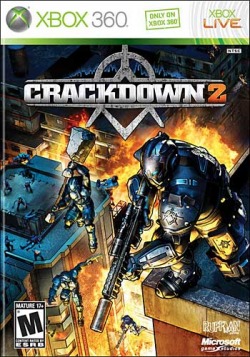
by Brian LeTendre
The original “Crackdown” may be my favorite game of this generation. Cleaning up the gang-ridden streets of Pacific City as a super-powered cop was pure, unadulterated fun. With “Crackdown 2,” developer Ruffian Games has kept everything that was great about the first game, and added in a few new features as well.
The storyline in “Crackdown 2” picks up several years after the original game. The once beautiful Pacific city has fallen into chaos once again, as a plague was unleashed on the citizens that has mutated many of them into monsters called Freaks, who roam the streets at night, attacking citizens and Agency Peacekeepers alike. During the day the Freaks hide underground, but a terrorist group called The Cell battles the Agency and tries to thwart their attempts at restoring order. As the game progresses, the motivations of The Cell and the backstory of how things got this bad are revealed. Your main goal as an Agent is to retake strategic locations from the Cell as well as activate a series of devices (called Beacons) that will eradicate the Freak population, thus restoring order to the city.
Gameplay in “Crackdown 2” is essentially the same as the original, which is a good thing. You are a super-powered Agent that uses weapons, vehicles and hand to hand combat to take down enemies and restore order to the city. The more you use your skills, the better they become. The game world is also populated with orbs that improve certain skills when you collect them. Over the course of the game your agent eventually becomes the equivalent of the Hulk, able to leap huge distances, toss cars around like they were made of paper, and create massive shockwaves that rip through everything around you.
The biggest addition to “Crackdown 2” is how the day/night cycle affects the enemies you'll be dealing with. As soon as the sun goes down, the Freaks crawl out of the ground en masse. Depending on what your objective is as the time, this can have some interesting effects. There were times that I was attacking a Cell stronghold as night fell. The Freaks showed up and actually helped me, as they indiscriminately attacked anything that wasn't them. Battling Freaks also allows you to use your melee skills more, as they are a close combat enemy for the most part. I must have spent hours running through Freak-infested areas just pummeling wave after wave of enemies. It's a nice change of pace from the gunplay that makes up most encounters with the Cell.
“Crackdown 2” is an open world game, and you can explore most of it right out of the gate. The missions have a logical progression to them, but there's no penalty for getting sidetracked. Many a time I was on my way to complete the second leg of an objective, only to get sidetracked by a group of random enemies, or some agility orbs that I wanted to snag. Objectives are always represented on your map, and even if you do get sidetracked, chances are you'll end up near another objective anyway. There are some places you won't be able to explore until you've leveled up your Agent, and for the most part these are heights which you simply can't up to until you get to a certain skill level. For the most part though, there are very few limitations, even early in the game.
The other major upgrade in “Crackdown 2” is the addition of four-player co-op as well as 16-player competitive multiplayer. Co-op is especially helpful when you're attacking Freak lairs, as Beacons take a while to charge, and you have to fend off insane amounts of freaks while protecting the Beacons from damage. I was more interested in competitive multiplayer though, and I'm impressed with how well Ruffian pulled it off. In Deathmatch, Team Deathmatch and Rocket Tag modes you've essentially got a fully-powered Agent, so the action is fast, and the key to staying alive is constant movement. Adding to the verticality of each map are several glowing jump pads that vault you across the area, similar to the “Man Cannons” in “Halo 3.” There's also plenty of weapons scattered throughout each area, and multiplier orbs to collect that give bonuses for each kill. Overall the multiplayer works well, and it feels somewhere in between “Unreal Tournament III” and “Halo 3” to me.
“Crackdown 2” does a great job of building on the successful formula of the first game. I'll be spending plenty more time in Pacific City over the rest of the summer.
5 out of 5 Restoring Order By Any Means Necessaries
The original “Crackdown” may be my favorite game of this generation. Cleaning up the gang-ridden streets of Pacific City as a super-powered cop was pure, unadulterated fun. With “Crackdown 2,” developer Ruffian Games has kept everything that was great about the first game, and added in a few new features as well.
The storyline in “Crackdown 2” picks up several years after the original game. The once beautiful Pacific city has fallen into chaos once again, as a plague was unleashed on the citizens that has mutated many of them into monsters called Freaks, who roam the streets at night, attacking citizens and Agency Peacekeepers alike. During the day the Freaks hide underground, but a terrorist group called The Cell battles the Agency and tries to thwart their attempts at restoring order. As the game progresses, the motivations of The Cell and the backstory of how things got this bad are revealed. Your main goal as an Agent is to retake strategic locations from the Cell as well as activate a series of devices (called Beacons) that will eradicate the Freak population, thus restoring order to the city.
Gameplay in “Crackdown 2” is essentially the same as the original, which is a good thing. You are a super-powered Agent that uses weapons, vehicles and hand to hand combat to take down enemies and restore order to the city. The more you use your skills, the better they become. The game world is also populated with orbs that improve certain skills when you collect them. Over the course of the game your agent eventually becomes the equivalent of the Hulk, able to leap huge distances, toss cars around like they were made of paper, and create massive shockwaves that rip through everything around you.
The biggest addition to “Crackdown 2” is how the day/night cycle affects the enemies you'll be dealing with. As soon as the sun goes down, the Freaks crawl out of the ground en masse. Depending on what your objective is as the time, this can have some interesting effects. There were times that I was attacking a Cell stronghold as night fell. The Freaks showed up and actually helped me, as they indiscriminately attacked anything that wasn't them. Battling Freaks also allows you to use your melee skills more, as they are a close combat enemy for the most part. I must have spent hours running through Freak-infested areas just pummeling wave after wave of enemies. It's a nice change of pace from the gunplay that makes up most encounters with the Cell.
“Crackdown 2” is an open world game, and you can explore most of it right out of the gate. The missions have a logical progression to them, but there's no penalty for getting sidetracked. Many a time I was on my way to complete the second leg of an objective, only to get sidetracked by a group of random enemies, or some agility orbs that I wanted to snag. Objectives are always represented on your map, and even if you do get sidetracked, chances are you'll end up near another objective anyway. There are some places you won't be able to explore until you've leveled up your Agent, and for the most part these are heights which you simply can't up to until you get to a certain skill level. For the most part though, there are very few limitations, even early in the game.
The other major upgrade in “Crackdown 2” is the addition of four-player co-op as well as 16-player competitive multiplayer. Co-op is especially helpful when you're attacking Freak lairs, as Beacons take a while to charge, and you have to fend off insane amounts of freaks while protecting the Beacons from damage. I was more interested in competitive multiplayer though, and I'm impressed with how well Ruffian pulled it off. In Deathmatch, Team Deathmatch and Rocket Tag modes you've essentially got a fully-powered Agent, so the action is fast, and the key to staying alive is constant movement. Adding to the verticality of each map are several glowing jump pads that vault you across the area, similar to the “Man Cannons” in “Halo 3.” There's also plenty of weapons scattered throughout each area, and multiplier orbs to collect that give bonuses for each kill. Overall the multiplayer works well, and it feels somewhere in between “Unreal Tournament III” and “Halo 3” to me.
“Crackdown 2” does a great job of building on the successful formula of the first game. I'll be spending plenty more time in Pacific City over the rest of the summer.
5 out of 5 Restoring Order By Any Means Necessaries
6-18-10: Review--Alan Wake (XBox 360)
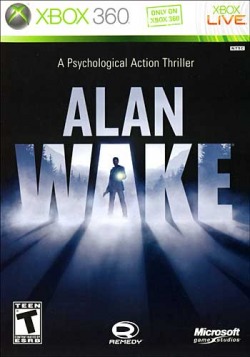
by Brian LeTendre
I’ve been waiting for “Alan Wake” for a long, long time. The game was first announced by developer Remedy at E3 2005. It started out as a multi-platform game, but ended up becoming an Xbox 360 exclusive. It wasn’t until 2008 that things started really coming together and now, finally, we get to see the finished product. Was it worth the wait? Absolutely.
“Alan Wake” takes inspiration from a lot of different horror and thriller icons—everything from Stephen King and David Lynch, from shows like “Lost” and “Twin Peaks,” to movies like “The Thing,” and games like “Silent Hill.” The story centers on writer Alan Wake, a successful Stephen King knockoff who has had writer’s block for the past two years. His wife Alice decides to get him out of the city and takes him on a vacation to the Pacific Northwest town of Bright Falls, where he can get away from it all and hopefully kick start his writing. All of that goes down the tubes however, when Alan’s wife disappears and he starts to realize something is very wrong with the town of Bright Falls. There is a darkness consuming many of the people in town, the nights are becoming extremely dangerous, and it seems like Alan’s latest novel is coming to life—even though he can’t remember writing any of it.
On the gameplay side, the core theme is that light is good, and darkness is really, really bad. Alan must use light to burn the darkness off of enemies before he can harm them. The flashlight beam acts as a reticule, and can also be used to stun enemies. Over the course of the game, Alan gains access to stronger light sources including flash grenades, flares, spotlights and handheld lanterns (really big flashlights). Revolvers, shotguns and hunting rifles are the standard weapons are his weapons of choice.
The mechanics work pretty well, and once I got into the rhythm of using the flashlight and weapons well together, combat takes on a certain fluidity. There’s also a dodge mechanic that will slow time down if you time it correctly, although sometimes your best move is just running toward the nearest light source, which drives the enemies away. There’s not a lot of depth to the combat system, as you pretty much learn everything in the first couple of encounters, but for me that was a good thing. I don’t want to be worried about learning new mechanics when I’m immersed in the atmosphere and story of the game.
Speaking of immersion, what really drew me into “Alan Wake” was its excellent presentation. The game’s six main chapters are treated as episodes of a television show. With each new episode, you get a recap of what happened in the previous one. In the game world itself, the use of light and darkness is very well done, and there is a constant sense of foreboding whenever there’s not a light source in the immediate vicinity. The darkness-possessed humans (called ‘Taken’) are freaky because they utter these insane babblings like “Omega-3 fatty acids are good for your heart!” or “The graveyard shift can give you cancer!” as they come stampeding out of the darkness toward you. All of those things combined with good pacing kept me engrossed throughout.
If there’s any gripe I have with the game it’s that the character models are not great, and that’s where the game really shows how long it’s been in development. The voice acting was great, but the character models just couldn’t convey emotion very well. As a result, the cutscenes are often the worst part of the game, as it looks better when it’s in motion and you’re taking control of Alan. Graphics aren’t that important to me though, so the strong story and atmosphere was more than enough for me to overlook some of the visuals.
“Alan Wake” is a game definitely worth playing, and it provides a unique experience at a time when much of the gaming landscape looks the same. Highly recommended.
4.5 out of 5 An Apple A Day Makes Sevens
I’ve been waiting for “Alan Wake” for a long, long time. The game was first announced by developer Remedy at E3 2005. It started out as a multi-platform game, but ended up becoming an Xbox 360 exclusive. It wasn’t until 2008 that things started really coming together and now, finally, we get to see the finished product. Was it worth the wait? Absolutely.
“Alan Wake” takes inspiration from a lot of different horror and thriller icons—everything from Stephen King and David Lynch, from shows like “Lost” and “Twin Peaks,” to movies like “The Thing,” and games like “Silent Hill.” The story centers on writer Alan Wake, a successful Stephen King knockoff who has had writer’s block for the past two years. His wife Alice decides to get him out of the city and takes him on a vacation to the Pacific Northwest town of Bright Falls, where he can get away from it all and hopefully kick start his writing. All of that goes down the tubes however, when Alan’s wife disappears and he starts to realize something is very wrong with the town of Bright Falls. There is a darkness consuming many of the people in town, the nights are becoming extremely dangerous, and it seems like Alan’s latest novel is coming to life—even though he can’t remember writing any of it.
On the gameplay side, the core theme is that light is good, and darkness is really, really bad. Alan must use light to burn the darkness off of enemies before he can harm them. The flashlight beam acts as a reticule, and can also be used to stun enemies. Over the course of the game, Alan gains access to stronger light sources including flash grenades, flares, spotlights and handheld lanterns (really big flashlights). Revolvers, shotguns and hunting rifles are the standard weapons are his weapons of choice.
The mechanics work pretty well, and once I got into the rhythm of using the flashlight and weapons well together, combat takes on a certain fluidity. There’s also a dodge mechanic that will slow time down if you time it correctly, although sometimes your best move is just running toward the nearest light source, which drives the enemies away. There’s not a lot of depth to the combat system, as you pretty much learn everything in the first couple of encounters, but for me that was a good thing. I don’t want to be worried about learning new mechanics when I’m immersed in the atmosphere and story of the game.
Speaking of immersion, what really drew me into “Alan Wake” was its excellent presentation. The game’s six main chapters are treated as episodes of a television show. With each new episode, you get a recap of what happened in the previous one. In the game world itself, the use of light and darkness is very well done, and there is a constant sense of foreboding whenever there’s not a light source in the immediate vicinity. The darkness-possessed humans (called ‘Taken’) are freaky because they utter these insane babblings like “Omega-3 fatty acids are good for your heart!” or “The graveyard shift can give you cancer!” as they come stampeding out of the darkness toward you. All of those things combined with good pacing kept me engrossed throughout.
If there’s any gripe I have with the game it’s that the character models are not great, and that’s where the game really shows how long it’s been in development. The voice acting was great, but the character models just couldn’t convey emotion very well. As a result, the cutscenes are often the worst part of the game, as it looks better when it’s in motion and you’re taking control of Alan. Graphics aren’t that important to me though, so the strong story and atmosphere was more than enough for me to overlook some of the visuals.
“Alan Wake” is a game definitely worth playing, and it provides a unique experience at a time when much of the gaming landscape looks the same. Highly recommended.
4.5 out of 5 An Apple A Day Makes Sevens
5-18-10: Review--Skate 3 (XBox 360)
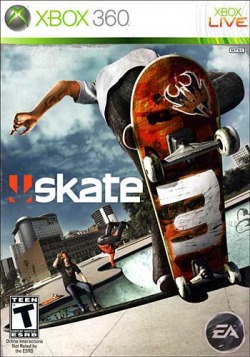
by Brian LeTendre
When it comes to video games, my skateboarding history begins and ends over twenty years ago. In the 80’s I played and enjoyed “720” in the arcade, and “Skate or Die” and “California Games” for the NES. I never really got into any other skating games over the years, and although the first couple “Skate” games looked interesting from afar, they seemed to be pretty difficult and sim-like, so I never approached them. So when “Skate 3” was building up to release, I was intrigued to hear the developers talking about opening up the series to a wider audience, and making it more accessible for newcomers. After spending some time with “Skate 3,” I’m happy to say that not only is the game newbie-friendly, it’s also has a lot more depth than I was expecting from it.
The story in “Skate 3” is simple—you are starting up your own skateboard company, and you have to drum up business. Getting on magazine covers, winning races, and filming your best tricks all result in the sale of more skateboards, and your sales numbers are basically the currency you use to unlock everything from new clothes to new challenges and locations. You also expand your company as you go by bringing on teammates to represent your brand, and they can earn you more sales.
The game is set in the city of Port Carverton, a virtual skater’s paradise. You can’t go ten feet in PC without finding something to jump, grind or flip off of. From the PCU campus to the downtown district to residential areas, there’s plenty of variety to the environments you can skate in, and since the game allows you to teleport to different areas, you can get skating in your favorite areas without having to travel all the way across town. If you’re at the college and you want to complete a challenge downtown, you just open the map, select the challenge icon and teleport over to that part of town. In Career Mode, the game does a nice job of keeping you constantly engaged in one challenge or another. However, it also gives you the option to turn the Career Mode off and just free skate around the city, if that’s what you’re looking for.
The story, setting and game modes wouldn’t matter much if the game’s core mechanics didn’t work, and fortunately for “Skate 3,” they work great. The basic skate trick system is called the ‘Flick It’ system, which has you using the right analog stick to move your board, and the left stick to move your body. Tricks are done by completing certain motions with the right stick—it actually feels similar to some sports and fighting games, and there’s a variety of motions that result in different moves. How easy the tricks are to pull off depends on what difficulty you set the game on, and this is where “Skate 3” really opens itself up to a wider audience. On Easy (which is what I play on), you are making the same movements as in other modes, but you don’t have to be as precise, and objects you interact with are more forgiving. As you ramp up the difficulty, your timing and movement inputs need to be better.
In addition to the different difficulty settings, “Skate 3” also has a great tutorial for newcomers. Jason Lee (My Name Is Earl, Mallrats) plays “Coach Frank,” basically an over the top version of his Earl character, decked out in tennis gear. He guides you through learning the basics of the game in a genuinely funny way. In fact, the entire game has a great sense of humor and charm, and it’s funny without being vulgar, which makes it a lot more accessible to younger players.
A big theme in “Skate 3” is creating your own content. Whether it’s video, custom graphics, or entire skate parts, “Skate 3” has a great set of creating and sharing tools that make it easy to customize your own experience. I don’t have a lick of artistic talent, but I was able to navigate the graphics creator on the game’s website (www.skate.ea.com) and create a logo for my boards, shirts and hats that I then imported in my game. There’s already a ton of videos, logos and parks that users have created that you can check out and can download, and the creative community around “Skate 3” is a great reason to keep coming back to the game.
Another big theme in "Skate 3" is being part of a team. A lot of the challenges are team-based, and you can either choose to have AI teammates, or hop online and recruit some friends. The game is flexible enough so that you can play the challenges either online or offline, and you usually get a bonus for choosing the online option. It's a nice way of encouraging online play without forcing it.
If I have one gripe about “Skate 3,” it's that even on the easiest difficulty, it's can be unforgiving at times. The tricks are simple enough to learn, but to able to string them together or time them correctly will take a while to learn, and the game will often put you on a timer during challenges, so there's not much room for error. On the flipside though, if you get frustrated with a challenge you can just quit out of it, open the map and instantly teleport to a different challenge.
All in all, “Skate 3” is a very well-rounded experience. From the “pick up and play” controls, to the online features, to the ability to create endless content, there's a lot of reasons to give this game a try. Even if you haven't played a skating game in a long time, you'll find plenty to like about “Skate 3.”
4.5 out of 5 Nollies
When it comes to video games, my skateboarding history begins and ends over twenty years ago. In the 80’s I played and enjoyed “720” in the arcade, and “Skate or Die” and “California Games” for the NES. I never really got into any other skating games over the years, and although the first couple “Skate” games looked interesting from afar, they seemed to be pretty difficult and sim-like, so I never approached them. So when “Skate 3” was building up to release, I was intrigued to hear the developers talking about opening up the series to a wider audience, and making it more accessible for newcomers. After spending some time with “Skate 3,” I’m happy to say that not only is the game newbie-friendly, it’s also has a lot more depth than I was expecting from it.
The story in “Skate 3” is simple—you are starting up your own skateboard company, and you have to drum up business. Getting on magazine covers, winning races, and filming your best tricks all result in the sale of more skateboards, and your sales numbers are basically the currency you use to unlock everything from new clothes to new challenges and locations. You also expand your company as you go by bringing on teammates to represent your brand, and they can earn you more sales.
The game is set in the city of Port Carverton, a virtual skater’s paradise. You can’t go ten feet in PC without finding something to jump, grind or flip off of. From the PCU campus to the downtown district to residential areas, there’s plenty of variety to the environments you can skate in, and since the game allows you to teleport to different areas, you can get skating in your favorite areas without having to travel all the way across town. If you’re at the college and you want to complete a challenge downtown, you just open the map, select the challenge icon and teleport over to that part of town. In Career Mode, the game does a nice job of keeping you constantly engaged in one challenge or another. However, it also gives you the option to turn the Career Mode off and just free skate around the city, if that’s what you’re looking for.
The story, setting and game modes wouldn’t matter much if the game’s core mechanics didn’t work, and fortunately for “Skate 3,” they work great. The basic skate trick system is called the ‘Flick It’ system, which has you using the right analog stick to move your board, and the left stick to move your body. Tricks are done by completing certain motions with the right stick—it actually feels similar to some sports and fighting games, and there’s a variety of motions that result in different moves. How easy the tricks are to pull off depends on what difficulty you set the game on, and this is where “Skate 3” really opens itself up to a wider audience. On Easy (which is what I play on), you are making the same movements as in other modes, but you don’t have to be as precise, and objects you interact with are more forgiving. As you ramp up the difficulty, your timing and movement inputs need to be better.
In addition to the different difficulty settings, “Skate 3” also has a great tutorial for newcomers. Jason Lee (My Name Is Earl, Mallrats) plays “Coach Frank,” basically an over the top version of his Earl character, decked out in tennis gear. He guides you through learning the basics of the game in a genuinely funny way. In fact, the entire game has a great sense of humor and charm, and it’s funny without being vulgar, which makes it a lot more accessible to younger players.
A big theme in “Skate 3” is creating your own content. Whether it’s video, custom graphics, or entire skate parts, “Skate 3” has a great set of creating and sharing tools that make it easy to customize your own experience. I don’t have a lick of artistic talent, but I was able to navigate the graphics creator on the game’s website (www.skate.ea.com) and create a logo for my boards, shirts and hats that I then imported in my game. There’s already a ton of videos, logos and parks that users have created that you can check out and can download, and the creative community around “Skate 3” is a great reason to keep coming back to the game.
Another big theme in "Skate 3" is being part of a team. A lot of the challenges are team-based, and you can either choose to have AI teammates, or hop online and recruit some friends. The game is flexible enough so that you can play the challenges either online or offline, and you usually get a bonus for choosing the online option. It's a nice way of encouraging online play without forcing it.
If I have one gripe about “Skate 3,” it's that even on the easiest difficulty, it's can be unforgiving at times. The tricks are simple enough to learn, but to able to string them together or time them correctly will take a while to learn, and the game will often put you on a timer during challenges, so there's not much room for error. On the flipside though, if you get frustrated with a challenge you can just quit out of it, open the map and instantly teleport to a different challenge.
All in all, “Skate 3” is a very well-rounded experience. From the “pick up and play” controls, to the online features, to the ability to create endless content, there's a lot of reasons to give this game a try. Even if you haven't played a skating game in a long time, you'll find plenty to like about “Skate 3.”
4.5 out of 5 Nollies
5-11-10: Review--Iron Man 2: The Video Game (PS3)
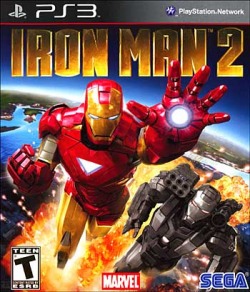
by Brian LeTendre
“Iron Man 2: The Video Game” is somewhat of a Jekyll and Hyde experience. The game contains a mix of fun superhero moments and controller-throwing, white-hot anger moments that in the end keep it from breaking the “movie tie-in” mold.
“Iron Man 2” features a story by writer Matt Fraction that takes place after the events of the Iron Man 2 movie. A former Stark employee by the name of Kearson DeWitt has stolen a bunch of information from the JARVIS AI program, and is working with the Russians and A.I.M. to create the Ultimo weapon. Tony and Rhodey have to battle through Russian separatists, Crimson Dynamo, Roxxon and A.I.M. on their way to tracking down DeWitt, who ends up becoming one with Ultimo. Along the way, they get some help from Nick Fury, Black Widow and S.H.I.E.L.D. Through the game's eight story missions, you get to choose to play as either Iron Man or War Machine (there are a couple missions where the story dictates that you use a certain suit).
The controls for both the Iron Man and War Machine suits are pretty much the same―it's the weaponry that changes. As you might imagine, War Machine specializes in heavy artillery, but is not as agile as Iron Man, who makes up for his lesser firepower by being more agile. The strongest aspect of the control scheme is the transition between ground movement, hovering and flying. Moving between modes is simple and easy, and I found myself using hover mode for most of the game, only using full flight and ground modes to either make up distance or navigate tight spaces, respectively. Weapons are controlled with the trigger buttons, and some weapons allow you to charge them up by holding the button down for a longer period. There's a lock on system that you can toggle on and off as well, which I found worked great in some situations and poorly in others. In general, the controls are simple to use and you should pick them up quickly.
As you play through he game, you'll unlock different Iron Man armors―everything from the original Iron Man suit to the Ultimate universe version. On top of that, there's a pretty deep customization system that allows you to upgrade weapons and create new ones. Before each mission, you can customize your loadout, and many of the weapons can be used with both iron man and War Machine, so you're not necessarily upgrading one at the expense of the other. You'll never unlock or upgrade everything in the first playthrough, so you'll have to prioritize the first time through.
The game is at its best when it gives you wide open spaces and a variety of targets to take down any way you want. A really fun sequence might start with Iron Man softening enemies up with a few missiles from afar, then dashing in to battle flying drones hand to hand before dropping to the ground to take on a couple of tanks, only to vault back up into the air when things get too hot.
Where “Iron Man 2” really stumbles though, is when it requires a level of precision that the game's mechanics are incapable of. It puts you in situations where you'll either need to fly through tight spaces, or interact with specific objects, and that's when things start to fall apart (especially when you're put on a timer). There's a scene that kind of like the old Star Wars arcade game for example, where you're flying out of a series of collapsing tunnels, having to dodge objects in each direction. The clunky camera and the looseness of the flying controls take what should be a cool superhero moment and turn it into a choppy, frustrating sequence, where I bumbled and stumbled my way out to the eventual cut scene.
The final boss is murder, too. Playing as both War Machine and Iron Man (you switch off), you make the final assault on Ultimo. War Machine's task is to disable and then pry off energy cores on Ultimo's body. This requires precision, as War Machine has to get in just the right position and press the interact button. Ultimo is constantly moving, and the hover/flight controls just aren't precise enough to get you in the right position at the exact moment you need to be. The level just devolves into a frustrating scene where you'll die over and over again, hoping to maneuver yourself into position out of blink luck more than any sort of skill. It kills what is supposed to be the climactic battle of the game.
What this game really needed was a co-op mode. Some of the control issues would have been easier to deal with if there was a second player, as one player could have drawn enemy fire while the other fumbled with whatever object interaction needed to take place. Not to mention, War Machine and Iron Man raining down destruction together would have been awesome, and it would have increased the replayability factor of the game quite a bit. As it stands, the major incentive to replay missions is to unlock all the suits and upgrade all of their components, which will likely only appeal to completionists.
Between the variety of suits and weapons, and the ability to attack levels as either War Machine or Iron Man, the pieces are in place for a solid game. But when it comes to the control scheme, the game confuses the word “simple” with “precise," and the difference between those two words is the difference between “Iron Man 2” being a decent game and a really good game.
3 out of 5 Shellheads
“Iron Man 2: The Video Game” is somewhat of a Jekyll and Hyde experience. The game contains a mix of fun superhero moments and controller-throwing, white-hot anger moments that in the end keep it from breaking the “movie tie-in” mold.
“Iron Man 2” features a story by writer Matt Fraction that takes place after the events of the Iron Man 2 movie. A former Stark employee by the name of Kearson DeWitt has stolen a bunch of information from the JARVIS AI program, and is working with the Russians and A.I.M. to create the Ultimo weapon. Tony and Rhodey have to battle through Russian separatists, Crimson Dynamo, Roxxon and A.I.M. on their way to tracking down DeWitt, who ends up becoming one with Ultimo. Along the way, they get some help from Nick Fury, Black Widow and S.H.I.E.L.D. Through the game's eight story missions, you get to choose to play as either Iron Man or War Machine (there are a couple missions where the story dictates that you use a certain suit).
The controls for both the Iron Man and War Machine suits are pretty much the same―it's the weaponry that changes. As you might imagine, War Machine specializes in heavy artillery, but is not as agile as Iron Man, who makes up for his lesser firepower by being more agile. The strongest aspect of the control scheme is the transition between ground movement, hovering and flying. Moving between modes is simple and easy, and I found myself using hover mode for most of the game, only using full flight and ground modes to either make up distance or navigate tight spaces, respectively. Weapons are controlled with the trigger buttons, and some weapons allow you to charge them up by holding the button down for a longer period. There's a lock on system that you can toggle on and off as well, which I found worked great in some situations and poorly in others. In general, the controls are simple to use and you should pick them up quickly.
As you play through he game, you'll unlock different Iron Man armors―everything from the original Iron Man suit to the Ultimate universe version. On top of that, there's a pretty deep customization system that allows you to upgrade weapons and create new ones. Before each mission, you can customize your loadout, and many of the weapons can be used with both iron man and War Machine, so you're not necessarily upgrading one at the expense of the other. You'll never unlock or upgrade everything in the first playthrough, so you'll have to prioritize the first time through.
The game is at its best when it gives you wide open spaces and a variety of targets to take down any way you want. A really fun sequence might start with Iron Man softening enemies up with a few missiles from afar, then dashing in to battle flying drones hand to hand before dropping to the ground to take on a couple of tanks, only to vault back up into the air when things get too hot.
Where “Iron Man 2” really stumbles though, is when it requires a level of precision that the game's mechanics are incapable of. It puts you in situations where you'll either need to fly through tight spaces, or interact with specific objects, and that's when things start to fall apart (especially when you're put on a timer). There's a scene that kind of like the old Star Wars arcade game for example, where you're flying out of a series of collapsing tunnels, having to dodge objects in each direction. The clunky camera and the looseness of the flying controls take what should be a cool superhero moment and turn it into a choppy, frustrating sequence, where I bumbled and stumbled my way out to the eventual cut scene.
The final boss is murder, too. Playing as both War Machine and Iron Man (you switch off), you make the final assault on Ultimo. War Machine's task is to disable and then pry off energy cores on Ultimo's body. This requires precision, as War Machine has to get in just the right position and press the interact button. Ultimo is constantly moving, and the hover/flight controls just aren't precise enough to get you in the right position at the exact moment you need to be. The level just devolves into a frustrating scene where you'll die over and over again, hoping to maneuver yourself into position out of blink luck more than any sort of skill. It kills what is supposed to be the climactic battle of the game.
What this game really needed was a co-op mode. Some of the control issues would have been easier to deal with if there was a second player, as one player could have drawn enemy fire while the other fumbled with whatever object interaction needed to take place. Not to mention, War Machine and Iron Man raining down destruction together would have been awesome, and it would have increased the replayability factor of the game quite a bit. As it stands, the major incentive to replay missions is to unlock all the suits and upgrade all of their components, which will likely only appeal to completionists.
Between the variety of suits and weapons, and the ability to attack levels as either War Machine or Iron Man, the pieces are in place for a solid game. But when it comes to the control scheme, the game confuses the word “simple” with “precise," and the difference between those two words is the difference between “Iron Man 2” being a decent game and a really good game.
3 out of 5 Shellheads
5-7-10: Review--The Saboteur (XBox 360)
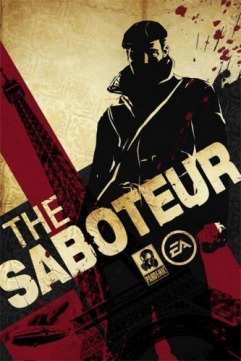
by Brian LeTendre
“The Saboteur” as a whole is much greater than the sum of its parts. It’s a World War II action game that combines a lot of familiar elements to create a very unique experience.
“The Saboteur” takes place in 1940 France and centers around the character of Sean Devlin, an Irish mechanic-turned racecar driver. When the Nazis invade France and Devlin’s best friend is killed, he gets sucked into the resistance movement and becomes a major force for the Parisian underground. Devlin wreaks havoc against the German forces as a saboteur, restoring the people’s will to fight and weakening the Nazis’ hold on the area, all while seeking revenge against the man who killed his friend.
The core gameplay in “The Saboteur” involves five major elements: platforming, sneaking, shooting, brawling and driving. All of the missions you undertake for various members of the resistance involve a combination of these elements. For example, a typical mission could be to sneak into a Nazi installation, use your brawling skills to take down Nazis quietly, blow up a communications tower, and then evade the alerted Nazis in a high speed chase through the streets of Paris. What’s great about both the sneaking and shooting however is that you can play the game in a way that emphasizes one element over the other. It’s possible in most missions to be completely stealthy, taking out guards silently and then slipping into the night after you complete your objective. If you’re a “run and gunner,’ you can blast your way through missions, provided you bring the right firepower and use cover effectively. My preference was always to attempt to be stealthy, and then bring out the big guns when I inevitable alerted the guards.
One of the coolest aspects of “The Saboteur” is its use of color. When you start the game, the entire area of France it takes place is drained of color, with the exception of the red Nazi banners and armbands. When you complete major story missions, the natural color of the world returns, as it signifies the French people’s will to fight back against the Nazis. Over the course of the game, the entire area gets bright back to life. That’s not to say the war’s over, just that the resistance has grown stronger and the people are willing to battle against the occupation.
I think the big tradeoff in a game this ambitious is that some aspects aren’t going to be as polished as they would be in a game that had a smaller focus. The driving mechanics aren’t as tight as they would be in a driving-focused game like “Burnout Paradise.” The sneak mechanics aren’t as polished as a game like “Metal Gear Solid” or “Splinter Cell.” Shooting doesn’t measure up to “Gears of War,” and the platforming doesn’t rival “Assassin’s Creed.” Those games do one or two things very well. The Saboteur does all of them in a fairly average way, which can lead to a frustrating moment or two. Trying to win a race when the car sometimes feels like it has one wheel in the middle instead of one on each corner can be difficult. There were times where I snuck up on a Nazi guard, and because I wasn’t in exactly the right position behind him, I couldn’t execute a stealth kill. Other times the clunky brawling mechanics kept me from being able to finish off a guard before he alerted his buddies. It was never enough to keep me from enjoying the game, but it was noticeable.
As I mentioned though, it’s a tradeoff, and it’s one that I’m completely comfortable with. Being able to explore a huge open world in a bunch of different ways is what makes “The Saboteur” great. Couple that with a really interesting story and “The Saboteur” manages to take the ‘done to death’ genre of World War II and make it a really interesting backdrop for a game again. It’s a shame that Pandemic was basically closed after this game was released, as I would've loved to have seen a sequel. It’s a criminally overlooked gem, and I highly recommended it.
4.5 out of 5 Viva La Resistances
You can pick up “The Saboteur” brand new at most retail outlets for $19.99 right now. For the amount of game you’ll be getting, you’d be hard pressed to find a better value.
“The Saboteur” as a whole is much greater than the sum of its parts. It’s a World War II action game that combines a lot of familiar elements to create a very unique experience.
“The Saboteur” takes place in 1940 France and centers around the character of Sean Devlin, an Irish mechanic-turned racecar driver. When the Nazis invade France and Devlin’s best friend is killed, he gets sucked into the resistance movement and becomes a major force for the Parisian underground. Devlin wreaks havoc against the German forces as a saboteur, restoring the people’s will to fight and weakening the Nazis’ hold on the area, all while seeking revenge against the man who killed his friend.
The core gameplay in “The Saboteur” involves five major elements: platforming, sneaking, shooting, brawling and driving. All of the missions you undertake for various members of the resistance involve a combination of these elements. For example, a typical mission could be to sneak into a Nazi installation, use your brawling skills to take down Nazis quietly, blow up a communications tower, and then evade the alerted Nazis in a high speed chase through the streets of Paris. What’s great about both the sneaking and shooting however is that you can play the game in a way that emphasizes one element over the other. It’s possible in most missions to be completely stealthy, taking out guards silently and then slipping into the night after you complete your objective. If you’re a “run and gunner,’ you can blast your way through missions, provided you bring the right firepower and use cover effectively. My preference was always to attempt to be stealthy, and then bring out the big guns when I inevitable alerted the guards.
One of the coolest aspects of “The Saboteur” is its use of color. When you start the game, the entire area of France it takes place is drained of color, with the exception of the red Nazi banners and armbands. When you complete major story missions, the natural color of the world returns, as it signifies the French people’s will to fight back against the Nazis. Over the course of the game, the entire area gets bright back to life. That’s not to say the war’s over, just that the resistance has grown stronger and the people are willing to battle against the occupation.
I think the big tradeoff in a game this ambitious is that some aspects aren’t going to be as polished as they would be in a game that had a smaller focus. The driving mechanics aren’t as tight as they would be in a driving-focused game like “Burnout Paradise.” The sneak mechanics aren’t as polished as a game like “Metal Gear Solid” or “Splinter Cell.” Shooting doesn’t measure up to “Gears of War,” and the platforming doesn’t rival “Assassin’s Creed.” Those games do one or two things very well. The Saboteur does all of them in a fairly average way, which can lead to a frustrating moment or two. Trying to win a race when the car sometimes feels like it has one wheel in the middle instead of one on each corner can be difficult. There were times where I snuck up on a Nazi guard, and because I wasn’t in exactly the right position behind him, I couldn’t execute a stealth kill. Other times the clunky brawling mechanics kept me from being able to finish off a guard before he alerted his buddies. It was never enough to keep me from enjoying the game, but it was noticeable.
As I mentioned though, it’s a tradeoff, and it’s one that I’m completely comfortable with. Being able to explore a huge open world in a bunch of different ways is what makes “The Saboteur” great. Couple that with a really interesting story and “The Saboteur” manages to take the ‘done to death’ genre of World War II and make it a really interesting backdrop for a game again. It’s a shame that Pandemic was basically closed after this game was released, as I would've loved to have seen a sequel. It’s a criminally overlooked gem, and I highly recommended it.
4.5 out of 5 Viva La Resistances
You can pick up “The Saboteur” brand new at most retail outlets for $19.99 right now. For the amount of game you’ll be getting, you’d be hard pressed to find a better value.
5-2-10: Review--Battlefield: Bad Company 2 Multiplayer (Xbox 360)

by Brian LeTendre
I’ve been putting this off because I haven’t finished the single-player campaign yet, but I can wait no longer. I have to talk about how amazing the multiplayer in “Battlefield: Bad Company 2” is.
I enjoyed the multiplayer in the first “Bad Company,” and I had a blast with “Battlefield 1943” this past summer. What’s great about “Bad Company 2” is that it feels like developer DICE really learned what worked and didn’t in both of those games, as they’ve crafted a superb multiplayer experience.
The four classes in “Bad Company 2” (Assault, Medic, Engineer and Recon) are very different from one another, and all have real pros and cons to playing them. Take the Medic for example, which is my preferred class. The biggest pro to playing a medic is that you can heal and resurrect teammates, which not only helps your team, but nets you huge amounts of experience points, which lead to better weapons and gear. One of the cons is that you don’t have a heavy duty weapon like a rocket launcher, and your light machine guns are pretty slow to reload. Some of the unlocks you get help alleviate those cons, but in general the Medic is a support class, and doesn’t so as well when trying to lead the charge alone or attack from far away. All of the classes are well crafted and work best when they fulfill the roles they were designed for. Recon is great at sniping and spotting, as well as calling in mortar support. Engineers are at their best when they are keeping allied vehicles up and running, and they can also quickly take out enemy vehicles. Assault is exactly what you think it is—strike fast, strike hard and lead the charge.
The classes are designed so well, having a good variety in your group can make your squad (and your team as a whole) near-unstoppable. In fact, the whole multiplayer component is designed in a way that constantly encourages teamwork. The game rewards you for assisting your squad by giving you extra experience points for healing or resupplying teammates, or assisting a squad mate with a kill. You can spot enemies for teammates, and you receive a bonus when someone takes the enemy out. And at the end of each match, you can earn bonus points for being the best team, or playing your role really well. Between the well-defined classes and the RPG-like experience system, “Bad Company 2” also scratched that “Dungeons & Dragons” itch for me. After all, running around the battlefield healing and resurrecting your party members is what being a cleric is all about.
But perhaps my favorite aspect of “Bad Company 2’s” multiplayer is the way the game is balanced. With the ability to use so many vehicles, and the variety of classes and weapons, it would be easy for a game like “Bad Company 2” to have major balance issues. For the most part though, the game is balanced very well. When you have two teams that are working together, matches often come down to one or two kills, or a last stand to defend a control point. Most sessions that I play with my friends have at least one or two epic battles that are decided by a slim margin.
“Bad Company 2” really provides a multiplayer experience that differs from almost everything else on consoles. The emphasis on teamwork, combined with the great class system, variety of vehicles and balanced gameplay combine for a great online experience. In fact, it’s so good that you may gloss over the single-player component entirely.
5 out of 5 Cure Light Wounds
I’ve been putting this off because I haven’t finished the single-player campaign yet, but I can wait no longer. I have to talk about how amazing the multiplayer in “Battlefield: Bad Company 2” is.
I enjoyed the multiplayer in the first “Bad Company,” and I had a blast with “Battlefield 1943” this past summer. What’s great about “Bad Company 2” is that it feels like developer DICE really learned what worked and didn’t in both of those games, as they’ve crafted a superb multiplayer experience.
The four classes in “Bad Company 2” (Assault, Medic, Engineer and Recon) are very different from one another, and all have real pros and cons to playing them. Take the Medic for example, which is my preferred class. The biggest pro to playing a medic is that you can heal and resurrect teammates, which not only helps your team, but nets you huge amounts of experience points, which lead to better weapons and gear. One of the cons is that you don’t have a heavy duty weapon like a rocket launcher, and your light machine guns are pretty slow to reload. Some of the unlocks you get help alleviate those cons, but in general the Medic is a support class, and doesn’t so as well when trying to lead the charge alone or attack from far away. All of the classes are well crafted and work best when they fulfill the roles they were designed for. Recon is great at sniping and spotting, as well as calling in mortar support. Engineers are at their best when they are keeping allied vehicles up and running, and they can also quickly take out enemy vehicles. Assault is exactly what you think it is—strike fast, strike hard and lead the charge.
The classes are designed so well, having a good variety in your group can make your squad (and your team as a whole) near-unstoppable. In fact, the whole multiplayer component is designed in a way that constantly encourages teamwork. The game rewards you for assisting your squad by giving you extra experience points for healing or resupplying teammates, or assisting a squad mate with a kill. You can spot enemies for teammates, and you receive a bonus when someone takes the enemy out. And at the end of each match, you can earn bonus points for being the best team, or playing your role really well. Between the well-defined classes and the RPG-like experience system, “Bad Company 2” also scratched that “Dungeons & Dragons” itch for me. After all, running around the battlefield healing and resurrecting your party members is what being a cleric is all about.
But perhaps my favorite aspect of “Bad Company 2’s” multiplayer is the way the game is balanced. With the ability to use so many vehicles, and the variety of classes and weapons, it would be easy for a game like “Bad Company 2” to have major balance issues. For the most part though, the game is balanced very well. When you have two teams that are working together, matches often come down to one or two kills, or a last stand to defend a control point. Most sessions that I play with my friends have at least one or two epic battles that are decided by a slim margin.
“Bad Company 2” really provides a multiplayer experience that differs from almost everything else on consoles. The emphasis on teamwork, combined with the great class system, variety of vehicles and balanced gameplay combine for a great online experience. In fact, it’s so good that you may gloss over the single-player component entirely.
5 out of 5 Cure Light Wounds
4-27-10: Super Street Fighter 4 Review (XBox 360)
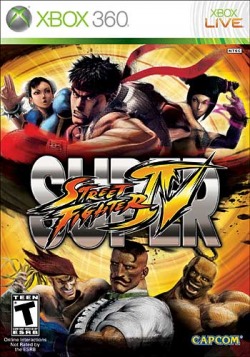
by Brian LeTendre
“Street Fighter 4” exploded onto the console gaming scene in February of 2009. The game was pretty much universally acclaimed for everything from the new art style, to the new combo system, to the roster of both familiar and new characters. “Street Fighter 4” was everything that fans of the franchise had hoped it would be. But when Capcom announced that “Super Street Fighter 4” would be arriving a little over a year after the original game, some fans and critics wondered aloud if it was too soon, and questioned why Capcom couldn’t just make additional content available through download.
Now that “Super Street Fighter 4” has hit store shelves however, it’s hard to argue with the value of the final product. “Super Street Fighter 4” is a great package, and it’s a lot more accessible to new players than last year’s model.
“Super Street Fighter 4” adds a host a new features to the game, chief among them being the ten new characters. Well, two of them are new, and eight of the characters are returning from previous “Street Fighter” games. For me, the standouts in the group are Cody and Guy of the “Final Fight” series, as well as the two new characters Hakan and Juri. I loved the side-scrolling beat ‘em up badness of "Final Fight," so I was psyched to see them included in "SSFIV." The two true new characters are very different from both each other and the other characters in the game. Juri, who uses a style of Tae Kwon Do, is a quick, kick-based character whose attacks include vicious wheel kicks that juggle opponents in the air, as well as projectile attacks that make her a dangerous ranged opponent. Hakan is a Turkish oil wrestler that bathes himself in olive oil before the start of each match. He’s powerful and has some great ground attacks, like the ability to slide on his oil-covered stomach, knocking opponents to the ground so he can immediately belly flop back on top of them. All in all there's a ton of characters to choose from, and they are all unlocked from the start of the game, which makes the game much more accessible that "Street Fighter 4," where many of the characters had to be unlocked by playing through Arcade mode with other characters.
The online component of “Super Street Fighter 4” is where things have really stepped up since the first version. The new Team Battle mode allows up to eight players to face off in teams of two, three or four. Endless Battle is just like the old arcade days, where up to eight people face off one at a time and the winner stays while the loser moves to the end of the challenger line. As far as performance, I had no lag issues during the merciless beatings I took over Xbox Live. But by far my favorite mode is the Replay Channel, which allows you to watch recorded matches from all around the world. The Replay Channel has sub-channels, so if you just want to watch matched featuring the new characters, or just characters from the original game, you can. It's a great training tool, as I was able to see how people who knew what they were doing used my favorite characters. You can literally sit in a lobby and match after match will play. It's like watching the really good kids at the arcade without that awkward feeling of looking over their shoulders.
My only gripe with the game is that the Training and Trial modes where you learn and practice your moves are not as helpful as I'd like them to be. They never show you why you failed to pull off a move. I'd love to see a system like in “MLB 2K10,” where the game shows you the motion you made with the stick, and how far away it was from the ideal motion. It would make learning new moves a lot easier.
Between the fantastic gameplay and the new modes and characters, “Super Street Fighter 4” is a great package. If you already own Street Fighter 4, then you'll have to decide whether the new characters and online upgrades are enough to buy the new edition, but it's a no-brainer for anyone who didn't get "SFIV," as this is the superior version, and it's twenty bucks cheaper than its predecessor.
4.5 out of 5 Oil Slides
“Street Fighter 4” exploded onto the console gaming scene in February of 2009. The game was pretty much universally acclaimed for everything from the new art style, to the new combo system, to the roster of both familiar and new characters. “Street Fighter 4” was everything that fans of the franchise had hoped it would be. But when Capcom announced that “Super Street Fighter 4” would be arriving a little over a year after the original game, some fans and critics wondered aloud if it was too soon, and questioned why Capcom couldn’t just make additional content available through download.
Now that “Super Street Fighter 4” has hit store shelves however, it’s hard to argue with the value of the final product. “Super Street Fighter 4” is a great package, and it’s a lot more accessible to new players than last year’s model.
“Super Street Fighter 4” adds a host a new features to the game, chief among them being the ten new characters. Well, two of them are new, and eight of the characters are returning from previous “Street Fighter” games. For me, the standouts in the group are Cody and Guy of the “Final Fight” series, as well as the two new characters Hakan and Juri. I loved the side-scrolling beat ‘em up badness of "Final Fight," so I was psyched to see them included in "SSFIV." The two true new characters are very different from both each other and the other characters in the game. Juri, who uses a style of Tae Kwon Do, is a quick, kick-based character whose attacks include vicious wheel kicks that juggle opponents in the air, as well as projectile attacks that make her a dangerous ranged opponent. Hakan is a Turkish oil wrestler that bathes himself in olive oil before the start of each match. He’s powerful and has some great ground attacks, like the ability to slide on his oil-covered stomach, knocking opponents to the ground so he can immediately belly flop back on top of them. All in all there's a ton of characters to choose from, and they are all unlocked from the start of the game, which makes the game much more accessible that "Street Fighter 4," where many of the characters had to be unlocked by playing through Arcade mode with other characters.
The online component of “Super Street Fighter 4” is where things have really stepped up since the first version. The new Team Battle mode allows up to eight players to face off in teams of two, three or four. Endless Battle is just like the old arcade days, where up to eight people face off one at a time and the winner stays while the loser moves to the end of the challenger line. As far as performance, I had no lag issues during the merciless beatings I took over Xbox Live. But by far my favorite mode is the Replay Channel, which allows you to watch recorded matches from all around the world. The Replay Channel has sub-channels, so if you just want to watch matched featuring the new characters, or just characters from the original game, you can. It's a great training tool, as I was able to see how people who knew what they were doing used my favorite characters. You can literally sit in a lobby and match after match will play. It's like watching the really good kids at the arcade without that awkward feeling of looking over their shoulders.
My only gripe with the game is that the Training and Trial modes where you learn and practice your moves are not as helpful as I'd like them to be. They never show you why you failed to pull off a move. I'd love to see a system like in “MLB 2K10,” where the game shows you the motion you made with the stick, and how far away it was from the ideal motion. It would make learning new moves a lot easier.
Between the fantastic gameplay and the new modes and characters, “Super Street Fighter 4” is a great package. If you already own Street Fighter 4, then you'll have to decide whether the new characters and online upgrades are enough to buy the new edition, but it's a no-brainer for anyone who didn't get "SFIV," as this is the superior version, and it's twenty bucks cheaper than its predecessor.
4.5 out of 5 Oil Slides
3-20-10: Deadly Premonition Review (XBox 360)
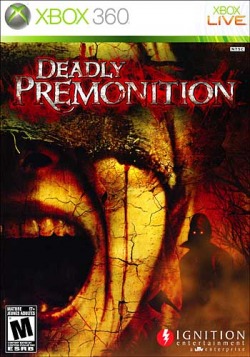
by Brian LeTendre
“Deadly Premonition” is one of the hardest games I’ve ever tried to review. The game is both amazing and terrible at the same time, and most people will either be madly in love with it, or hate the game completely. For me, the good far outweighed the bad, and I found “Deadly Premonition” to be one of the most interesting games I’ve played in a long time.
“Deadly Premonition” centers on Agent Francis York Morgan, who has come to the quiet Northwest town of Greenvale to investigate the murder of a young woman. Her death has revived rumors of the return of the “Raincoat Killer,” a serial murderer who shows up when it rains, which it happens to do in Greenvale quite a bit. More victims start piling up, putting York and the local police in a race against time to catch the killer before he or she strikes again. The story is broken up into chapters and episodes, which feature TV-style recap segments in between. “Deadly Premonition” is clearly inspired by the television show Twin Peaks in terms of story, and the gameplay is a mix of genres, pulling from games like “Resident Evil,” “Grand Theft Auto” and “Silent Hill.” You explore the open world of Greenvale, interview its townspeople, and engage in story missions, side quests and minigames while trying to find out who the killer is.
Let’s start with the negatives first, because there are some issues with “Deadly Premonition” that may make you walk away before you’re even out of the first chapter. The biggest issue is that much of the game’s control system is downright awful. The combat controls are reminiscent of “Resident Evil,” with ‘stop and shoot’ style, but the aiming is less precise. Luckily, there is a ‘lock on’ button that will shift your aim to the nearest enemy, which I relied on quite a bit, especially in the early going. Driving is not much better, as vehicles feel like they have one wheel in the middle as opposed to four on all sides. The inventory system is archaic, the minimap is not very helpful, and the tutorial is almost nonexistent. To cap it all off, the game has the visual fidelity of an early PS2 or original Xbox game. In short, “Deadly Premonition” does not look good or play very well, and the game does little to help you figure out what you’re supposed to be doing.
So, why would anyone want to put themselves through the frustrations I mentioned above? Because the writing, story and characters are some of the most unique I’ve encountered in a game, so much so that the things I didn’t like about the game just faded into the background.
Seriously, if you can get past the ugly wrapper, “Deadly Premonition” really is amazing. Lead character Agent Francis York Morgan is an FBI investigator with an imaginary friend named Zach. He spends most of his alone time musing about 80’s movies like “Ladyhawke,” or comparing the first two “Superman” movies to the first two entries in the “Star Wars” trilogy. It’s a movie nerd’s dream, and I was impressed on several occasions with how obscure some of the references were. York’s mannerisms and the way he interacts with others are really funny, and despite the story’s serious tone, there are a ton of laugh out loud moments in the game.
The supporting cast is interesting as well. Sheriff George Woodman and Deputy Sheriff Emily Wyatt are great, and many of the townsfolk have funny personalities too. They all go about their daily lives, and what you learn from them will depend on where and when you encounter them. Many side quests will only be found if you are in the right place at the right time, which encourages you to explore the town and get to know everyone.
As York makes his way through each chapter, there are times where he will use his profiling skills to put clues together. This usually involves finding pieces of evidence and watching York play out situations in his head. At the end of each chapter the process is a little more interactive, as York poses questions about the case that you have to answer. This served as a nice way to keep you engaged in the details of the story, as you’re constantly being reminded what’s come before and how it all fits together.
The third act features some great twists, and the plot in general jumps up a few notches on the crazy scale, but I found the story to be very satisfying overall. I felt a tinge of sadness at the end, because unless this game sells extremely well, there's very little chance I'll be seeing Agent Morgan in a game anytime soon. I may just have to play through the game again, as I'm sure there's plenty of golden moments that I missed in my 21-hour experience.
So, while “Deadly Premonition” can't be considered a good game from a technical standpoint, it's easily one of the most memorable games I've ever played. Do yourself a favor and check this one out. Oh yeah, I almost forgot to mention that it costs $20.
4 out of 5 Red Seeds
“Deadly Premonition” is one of the hardest games I’ve ever tried to review. The game is both amazing and terrible at the same time, and most people will either be madly in love with it, or hate the game completely. For me, the good far outweighed the bad, and I found “Deadly Premonition” to be one of the most interesting games I’ve played in a long time.
“Deadly Premonition” centers on Agent Francis York Morgan, who has come to the quiet Northwest town of Greenvale to investigate the murder of a young woman. Her death has revived rumors of the return of the “Raincoat Killer,” a serial murderer who shows up when it rains, which it happens to do in Greenvale quite a bit. More victims start piling up, putting York and the local police in a race against time to catch the killer before he or she strikes again. The story is broken up into chapters and episodes, which feature TV-style recap segments in between. “Deadly Premonition” is clearly inspired by the television show Twin Peaks in terms of story, and the gameplay is a mix of genres, pulling from games like “Resident Evil,” “Grand Theft Auto” and “Silent Hill.” You explore the open world of Greenvale, interview its townspeople, and engage in story missions, side quests and minigames while trying to find out who the killer is.
Let’s start with the negatives first, because there are some issues with “Deadly Premonition” that may make you walk away before you’re even out of the first chapter. The biggest issue is that much of the game’s control system is downright awful. The combat controls are reminiscent of “Resident Evil,” with ‘stop and shoot’ style, but the aiming is less precise. Luckily, there is a ‘lock on’ button that will shift your aim to the nearest enemy, which I relied on quite a bit, especially in the early going. Driving is not much better, as vehicles feel like they have one wheel in the middle as opposed to four on all sides. The inventory system is archaic, the minimap is not very helpful, and the tutorial is almost nonexistent. To cap it all off, the game has the visual fidelity of an early PS2 or original Xbox game. In short, “Deadly Premonition” does not look good or play very well, and the game does little to help you figure out what you’re supposed to be doing.
So, why would anyone want to put themselves through the frustrations I mentioned above? Because the writing, story and characters are some of the most unique I’ve encountered in a game, so much so that the things I didn’t like about the game just faded into the background.
Seriously, if you can get past the ugly wrapper, “Deadly Premonition” really is amazing. Lead character Agent Francis York Morgan is an FBI investigator with an imaginary friend named Zach. He spends most of his alone time musing about 80’s movies like “Ladyhawke,” or comparing the first two “Superman” movies to the first two entries in the “Star Wars” trilogy. It’s a movie nerd’s dream, and I was impressed on several occasions with how obscure some of the references were. York’s mannerisms and the way he interacts with others are really funny, and despite the story’s serious tone, there are a ton of laugh out loud moments in the game.
The supporting cast is interesting as well. Sheriff George Woodman and Deputy Sheriff Emily Wyatt are great, and many of the townsfolk have funny personalities too. They all go about their daily lives, and what you learn from them will depend on where and when you encounter them. Many side quests will only be found if you are in the right place at the right time, which encourages you to explore the town and get to know everyone.
As York makes his way through each chapter, there are times where he will use his profiling skills to put clues together. This usually involves finding pieces of evidence and watching York play out situations in his head. At the end of each chapter the process is a little more interactive, as York poses questions about the case that you have to answer. This served as a nice way to keep you engaged in the details of the story, as you’re constantly being reminded what’s come before and how it all fits together.
The third act features some great twists, and the plot in general jumps up a few notches on the crazy scale, but I found the story to be very satisfying overall. I felt a tinge of sadness at the end, because unless this game sells extremely well, there's very little chance I'll be seeing Agent Morgan in a game anytime soon. I may just have to play through the game again, as I'm sure there's plenty of golden moments that I missed in my 21-hour experience.
So, while “Deadly Premonition” can't be considered a good game from a technical standpoint, it's easily one of the most memorable games I've ever played. Do yourself a favor and check this one out. Oh yeah, I almost forgot to mention that it costs $20.
4 out of 5 Red Seeds
3-2-10: Plants Vs. Zombies Review (iPhone/iPod touch)
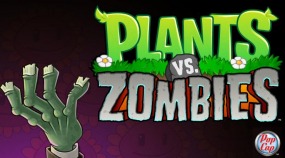
by Brian LeTendre
Developer Pop Cap has created an empire by continuously building better mousetraps. They look at the types of games and genres that are popular with people at any given time, and then they make their own version, only better. Their latest game “Plants vs. Zombies” was an instant hit when it debuted on PC in May of 2009, and the iPhone version that arrived this week is every bit as good as the original.
“Plants vs. Zombies” takes the very popular ‘tower defense’ style of game and combines it with everybody’s favorite monster—the zombie. While that may sound cliched, where Pop Cap sets themselves apart once again is in their execution. “Plants vs. Zombies” is mechanically sound, has a cute, cartoony aesthetic, and a great soundtrack. That combination results in a completely addictive experience that is perfectly at home on the iPhone/iPod Touch.
In “Plants vs. Zombies,” you defend your home from a zombie invasion by populating your lawn with different kinds of weaponized plants. Each plant costs a certain amount of sunlight to make grow, and you collect sunlight as you play the game. Some plants function like pea shooters, slowly chipping away at a zombie’s health. Some resemble the giant venus fly trap from ‘Little Shop of Horrors,’ and have the ability to eat a zombie whole. You can plant potato mines, which explode into a mess of mashed potatoes on impact. There’s also defensive plant types, like Wall-Nuts, which block the zombies from progressing until they eat through them. Finally, by planting sunflowers, you can increase the amount of sunlight you collect, allowing you to get more plants on your lawn more quickly.
By clearing waves of zombies, you earn rewards, which could be either new plant seeds or currency to buy other seed packs and upgrades. Since you can only have so many seed types in play at one time, there’s an element of customization to the game. It’s almost like you’re creating a deck in a collectible card game, selecting the plant types that fit your strategy best. The zombie types get more sophisticated as well, so each level will have you reassessing what types of plants you want in your arsenal, as well as prioritizing what you spend your sunlight on.
There are variations to the standard gameplay, and some levels will have you doing things like bowling for zombies with Wall-Nuts, or taking random plants off a conveyor belt and arranging them the best way you can to stop the zombies.
It may sound a little overwhelming, but the game eases you into things and never gives you more than you can handle, which makes it great for all types of gamers. The cartoony design, the charming humor and the lack of any gore or graphic violence also make “Plants vs. Zombies” a great game for all ages.
5 out of 5 Cob Cannons
Developer Pop Cap has created an empire by continuously building better mousetraps. They look at the types of games and genres that are popular with people at any given time, and then they make their own version, only better. Their latest game “Plants vs. Zombies” was an instant hit when it debuted on PC in May of 2009, and the iPhone version that arrived this week is every bit as good as the original.
“Plants vs. Zombies” takes the very popular ‘tower defense’ style of game and combines it with everybody’s favorite monster—the zombie. While that may sound cliched, where Pop Cap sets themselves apart once again is in their execution. “Plants vs. Zombies” is mechanically sound, has a cute, cartoony aesthetic, and a great soundtrack. That combination results in a completely addictive experience that is perfectly at home on the iPhone/iPod Touch.
In “Plants vs. Zombies,” you defend your home from a zombie invasion by populating your lawn with different kinds of weaponized plants. Each plant costs a certain amount of sunlight to make grow, and you collect sunlight as you play the game. Some plants function like pea shooters, slowly chipping away at a zombie’s health. Some resemble the giant venus fly trap from ‘Little Shop of Horrors,’ and have the ability to eat a zombie whole. You can plant potato mines, which explode into a mess of mashed potatoes on impact. There’s also defensive plant types, like Wall-Nuts, which block the zombies from progressing until they eat through them. Finally, by planting sunflowers, you can increase the amount of sunlight you collect, allowing you to get more plants on your lawn more quickly.
By clearing waves of zombies, you earn rewards, which could be either new plant seeds or currency to buy other seed packs and upgrades. Since you can only have so many seed types in play at one time, there’s an element of customization to the game. It’s almost like you’re creating a deck in a collectible card game, selecting the plant types that fit your strategy best. The zombie types get more sophisticated as well, so each level will have you reassessing what types of plants you want in your arsenal, as well as prioritizing what you spend your sunlight on.
There are variations to the standard gameplay, and some levels will have you doing things like bowling for zombies with Wall-Nuts, or taking random plants off a conveyor belt and arranging them the best way you can to stop the zombies.
It may sound a little overwhelming, but the game eases you into things and never gives you more than you can handle, which makes it great for all types of gamers. The cartoony design, the charming humor and the lack of any gore or graphic violence also make “Plants vs. Zombies” a great game for all ages.
5 out of 5 Cob Cannons
2-18-10: Skee-Ball Review (iPhone/iPod Touch)
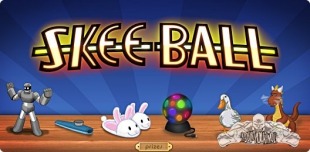
by Brian LeTendre
Remember the days where you’d head down to the arcade or the boardwalk and blow $20 bucks playing “Skee-Ball” just to get enough tickets for that Duran Duran velcro wallet?
Developer Freeverse remembers, and they’ve created a “Skee-Ball” game for the iPhone and iPod Touch that recaptures the magic of those ticket-collecting days.
“Skee-Ball” is exactly what you picture it to be in your head—that lighted sign on the top of the alley, the little chute where the balls roll down, and those glorious circles of varying sizes and point values, daring you to forgo the straight shot and try to angle one for 100 points. You throw balls down the alley by moving your finger up the screen. The game translates your motion and angle extremely well, and the physics provide as realistic a feel as possible to the gameplay.
As fun as playing "Skee-Ball" is though, it’s all about the loot. Freeverse really nailed this aspect of the game, as you will be able to spend your tickets on everything from lava lamps to popsicles to mullet wigs. What’s better is that every time you log into the game, the items available in the store will change. Anything you purchase gets placed in your own personal trophy room, so you can show off that plastic spider ring to your friends next time you’re waiting at the bus stop.
To top it all off, “Skee-Ball” has achievements and leaderboards, so you can challenge yourself and compare your skills with your buddies.
A simple concept executed to perfection, “Skee-Ball” is an absolute blast to play. Oh yeah, it also costs a whopping $0.99 on iTunes. Considering the hundreds of hours you’re going to lose to this game, that’s a pretty low-risk investment.
5 out of 5 Hundos
Remember the days where you’d head down to the arcade or the boardwalk and blow $20 bucks playing “Skee-Ball” just to get enough tickets for that Duran Duran velcro wallet?
Developer Freeverse remembers, and they’ve created a “Skee-Ball” game for the iPhone and iPod Touch that recaptures the magic of those ticket-collecting days.
“Skee-Ball” is exactly what you picture it to be in your head—that lighted sign on the top of the alley, the little chute where the balls roll down, and those glorious circles of varying sizes and point values, daring you to forgo the straight shot and try to angle one for 100 points. You throw balls down the alley by moving your finger up the screen. The game translates your motion and angle extremely well, and the physics provide as realistic a feel as possible to the gameplay.
As fun as playing "Skee-Ball" is though, it’s all about the loot. Freeverse really nailed this aspect of the game, as you will be able to spend your tickets on everything from lava lamps to popsicles to mullet wigs. What’s better is that every time you log into the game, the items available in the store will change. Anything you purchase gets placed in your own personal trophy room, so you can show off that plastic spider ring to your friends next time you’re waiting at the bus stop.
To top it all off, “Skee-Ball” has achievements and leaderboards, so you can challenge yourself and compare your skills with your buddies.
A simple concept executed to perfection, “Skee-Ball” is an absolute blast to play. Oh yeah, it also costs a whopping $0.99 on iTunes. Considering the hundreds of hours you’re going to lose to this game, that’s a pretty low-risk investment.
5 out of 5 Hundos
2-9-10: Tatsunoko vs. Capcom: Ultimate All-Stars Review (Wii)
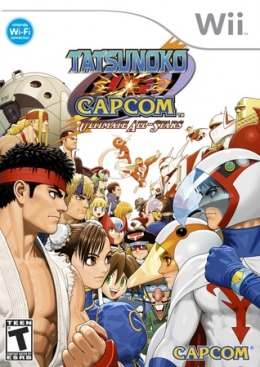
by Brian LeTendre
“Tatsunoko vs. Capcom: Ultimate All-Stars” is a great arcade-style fighter that offers something for both seasoned fighters and those new to the genre. A cast of colorful characters and a great set of gameplay options combine to make for a great fighting experience that hearkens back to the coin-op days.
“Tatsunoko vs. Capcom: Ultimate All-Stars” pits characters from the Capcom video games against those of Tatsunoko Productions, one of the most storied animation studios in Japan. There are 26 characters to choose from, and familiar characters like Ryu from “Street Fighter” and Ken the Eagle from “Gatchaman” are accompanied by more obscure characters like Gold Lightan (“Golden Warrior Gold Lightan”) and Saki Omokane (“Onimusha: Dawn of Dreams”).
As an arcade-style fighter, “Tatsunoko vs. Capcom” features pretty much everything you could ask for. There’s the standard Arcade mode, where you pick two characters and battle through a slew of enemy characters to face the final boss (Yami from “Okami”). Versus mode pits two players against one another locally. There’s also Time Attack and Survival Modes, which test your ability to dispatch enemies quickly and take out as many as possible without dying, respectively. And there’s a full featured online mode, which allows you to battle against friends or complete strangers online in ranked an unranked battles. Playing the game earns you in-game currency (Zenny) that you can use to unlock new character outfits, movies and artwork.
What really impressed me the most about this game can be summed up in one word though—accessibility. To control your fighters, you can choose to use the Wiimote, the Wiimote and Nunchuk, the Wii Classic Controller or a GameCube controller. The Wiimote control option features simple controls, which allow new players to pull off special moves and combos without being intimidated by the more complex controls. There’s even a “simple controls” option with the Wiimote that streamlines the controls further, mapping certain functions to basic motion controls. Combine that with a handicapping option in versus play, and each player can tailor the difficulty and controls to their skill level. As a father of two young kids with a wife who rarely games, the options available in “Tatsunoko vs. Capcom” make it a game that the entire family can play.
From a performance standpoint, the game looks and plays great. While the game is a 2D fighter, the characters and stages are 3D, which lends an additional layer of depth to the visuals. No matter what control scheme you’re using, the controls feel tight and responsive. In the online matches I played, there were one or two instances of minor lag, but for the most part I had no problems. It took about a minute on average to find a random opponent, and from there it was just like playing offline.
Aside from being a great all-around game, “Tatsunoko vs. Capcom: Ultimate All-Stars” is a good introduction to a lot of Tatsunoko’s franchises that many people may not be familiar with. I’ve already started tracking down DVDs of the ones I hadn’t seen before, like Karas and Tekkaman. On the flip side, if you’re an anime fan with little or no experience with fighting games, you’ll be able to get into this one without any problems. Highly recommended.
4.5 out of 5 K.O.’s
“Tatsunoko vs. Capcom: Ultimate All-Stars” is a great arcade-style fighter that offers something for both seasoned fighters and those new to the genre. A cast of colorful characters and a great set of gameplay options combine to make for a great fighting experience that hearkens back to the coin-op days.
“Tatsunoko vs. Capcom: Ultimate All-Stars” pits characters from the Capcom video games against those of Tatsunoko Productions, one of the most storied animation studios in Japan. There are 26 characters to choose from, and familiar characters like Ryu from “Street Fighter” and Ken the Eagle from “Gatchaman” are accompanied by more obscure characters like Gold Lightan (“Golden Warrior Gold Lightan”) and Saki Omokane (“Onimusha: Dawn of Dreams”).
As an arcade-style fighter, “Tatsunoko vs. Capcom” features pretty much everything you could ask for. There’s the standard Arcade mode, where you pick two characters and battle through a slew of enemy characters to face the final boss (Yami from “Okami”). Versus mode pits two players against one another locally. There’s also Time Attack and Survival Modes, which test your ability to dispatch enemies quickly and take out as many as possible without dying, respectively. And there’s a full featured online mode, which allows you to battle against friends or complete strangers online in ranked an unranked battles. Playing the game earns you in-game currency (Zenny) that you can use to unlock new character outfits, movies and artwork.
What really impressed me the most about this game can be summed up in one word though—accessibility. To control your fighters, you can choose to use the Wiimote, the Wiimote and Nunchuk, the Wii Classic Controller or a GameCube controller. The Wiimote control option features simple controls, which allow new players to pull off special moves and combos without being intimidated by the more complex controls. There’s even a “simple controls” option with the Wiimote that streamlines the controls further, mapping certain functions to basic motion controls. Combine that with a handicapping option in versus play, and each player can tailor the difficulty and controls to their skill level. As a father of two young kids with a wife who rarely games, the options available in “Tatsunoko vs. Capcom” make it a game that the entire family can play.
From a performance standpoint, the game looks and plays great. While the game is a 2D fighter, the characters and stages are 3D, which lends an additional layer of depth to the visuals. No matter what control scheme you’re using, the controls feel tight and responsive. In the online matches I played, there were one or two instances of minor lag, but for the most part I had no problems. It took about a minute on average to find a random opponent, and from there it was just like playing offline.
Aside from being a great all-around game, “Tatsunoko vs. Capcom: Ultimate All-Stars” is a good introduction to a lot of Tatsunoko’s franchises that many people may not be familiar with. I’ve already started tracking down DVDs of the ones I hadn’t seen before, like Karas and Tekkaman. On the flip side, if you’re an anime fan with little or no experience with fighting games, you’ll be able to get into this one without any problems. Highly recommended.
4.5 out of 5 K.O.’s
2-4-10: Review--Dragon Age: The Stolen Throne
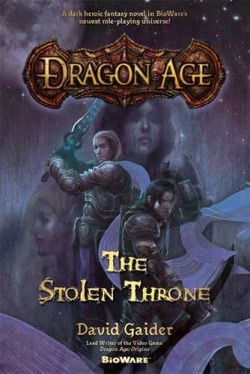
by Brian LeTendre
With “Dragon Age: The Stolen Throne,” writer David Gaider adds another level of depth to the world that he helped create for the “Dragon Age: Origins” video game.
“The Stolen Throne” is set approximately thirty years before the events of the “Dragon Age: Origins” game. The nation of Ferelden has been invaded and taken over by the Orlesian Empire, whose only major resistance is a group of rebels led by the former Queen Moira Theirin. When the Rebel Queen is killed, her son Maric escapes and ends up meeting a group of outlaws. With the Orlesians on his trail, Maric and an outlaw named Loghain Mac Tir escape into the wilds and eventually meet up with the remaining rebels. Maric then reluctantly takes up his mother's cause and embarks on a mission with Loghain and his betrothed Rowan to try and gather an army to overthrow the Orlesians. Love triangles, spies, Darkspawn and epic battles area all part of Maric's journey to the throne of Ferelden.
By setting this tale well before the events of the game, Gaider is able to focus on the history of Ferelden and some of it's most storied characters and events. While Maric is the lead character, this is Loghain's story as well, and he is a much different character here than the one players will encounter in the game. Reading this book could definitely impact how players approach Loghain in “Dragon Age: Origins.” This story also adds a lot of depth to the world of “Dragon Age,” particularly Ferelden. Locations from across Ferelden are explored in detail, and Gaider continuously imparts bits of each place's history to the reader, making Ferelden feel like much more than just the backdrop to video game.
If you're not planning on picking up the game and are just looking for a good fantasy tale, “The Stolen Throne” can certainly stand on its own. While it's clearly inspired by most of the other pillars of the fantasy genre, the characters are interesting enough to make the story feel unique.
Overall, “Dragon Age: The Stolen Throne” is a good fantasy tale that is highly recommended for anyone interested in the world of “Dragon Age."
4 out of 5 Darkspawn
With “Dragon Age: The Stolen Throne,” writer David Gaider adds another level of depth to the world that he helped create for the “Dragon Age: Origins” video game.
“The Stolen Throne” is set approximately thirty years before the events of the “Dragon Age: Origins” game. The nation of Ferelden has been invaded and taken over by the Orlesian Empire, whose only major resistance is a group of rebels led by the former Queen Moira Theirin. When the Rebel Queen is killed, her son Maric escapes and ends up meeting a group of outlaws. With the Orlesians on his trail, Maric and an outlaw named Loghain Mac Tir escape into the wilds and eventually meet up with the remaining rebels. Maric then reluctantly takes up his mother's cause and embarks on a mission with Loghain and his betrothed Rowan to try and gather an army to overthrow the Orlesians. Love triangles, spies, Darkspawn and epic battles area all part of Maric's journey to the throne of Ferelden.
By setting this tale well before the events of the game, Gaider is able to focus on the history of Ferelden and some of it's most storied characters and events. While Maric is the lead character, this is Loghain's story as well, and he is a much different character here than the one players will encounter in the game. Reading this book could definitely impact how players approach Loghain in “Dragon Age: Origins.” This story also adds a lot of depth to the world of “Dragon Age,” particularly Ferelden. Locations from across Ferelden are explored in detail, and Gaider continuously imparts bits of each place's history to the reader, making Ferelden feel like much more than just the backdrop to video game.
If you're not planning on picking up the game and are just looking for a good fantasy tale, “The Stolen Throne” can certainly stand on its own. While it's clearly inspired by most of the other pillars of the fantasy genre, the characters are interesting enough to make the story feel unique.
Overall, “Dragon Age: The Stolen Throne” is a good fantasy tale that is highly recommended for anyone interested in the world of “Dragon Age."
4 out of 5 Darkspawn
1-25-10: Dragon Age: Origins Review (XBox 360)
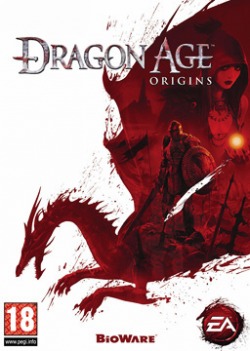
by Brian LeTendre
Bioware, you’ve finally done it. You managed to combine an RPG that embodies all of the things I love about playing “Dungeons & Dragons,” and meld it with a truly epic storyline to create a fantasy masterpiece.
“Dragon Age: Origins” takes all of the familiar concepts of “Lord of the Rings,” “Dragonlance,” “Wheel of Time” and every other fantasy setting and manages to do something unique with them. Instead of diving right into the overarching “save the world” story, “Dragon Age” takes a step back and allows you to play through the origin story of your character. In fact, you don’t encounter the main storyline of the game until several hours in, and that’s a good thing. By letting you actually play through your origin story, you’re completely bought into the world and your place in it when you hit the main storyline, giving the events that transpire a much greater impact.
As a Dwarven commoner, my character started out casteless, rejected by her own people. I spent time learning about the politics of Dwarven society and undertaking several quests for the crime lord I was working for, as I was a petty thief at the time. When one of the fabled Grey Wardens (the protectors of the land) comes to visit the city, an opportunity to rise beyond my current lot in life presented itself. By entering and winning a combat tournament, my character impressed the Grey Warden enough to earn an invitation to join the Wardens and help deal with a threat to the entire land. From there, my character’s story melded into the main storyline of the game, and the epic adventure began. Over forty hours later, I closed the book on one of the best fantasy stories I’ve ever experienced, and one that I felt was my story—my choices and actions created a story that was unique to my experience.
Great pacing, storytelling and voice acting more than offset the slightly outdated visuals in “Dragon Age: Origins.” It’s a tradeoff I’m completely fine with, as the graphics are certainly adequate, and after an hour I didn’t even pay attention to them anymore. The score is amazing, and I actually bought the soundtrack, which may be the first game soundtrack I’ve ever purchased. The presentation overall is fantastic. The final act of the game rivaled some of the best scenes from the "Lord of the Rings" series in terms of epic storytelling, and I actually went back and played through the same section twice just to watch the cutscenes again.
My only real complaint with “Dragon Age: Origins” is that when the story ends, you can’t continue to explore the world. That issue will be resolved in March however, when the first expansion pack for the game will allow me to embark on a whole new storyline with the character I played through the game with.
I cannot recommend “Dragon Age: Origins” highly enough for RPG fans, or those who enjoy a great fantasy story. Those who enjoyed the “Baldur’s Gate” series will also find a lot to love with this game, as it’s pretty much a spiritual successor to that series. Go buy it.
5 out of 5 For Fereldens!
Bioware, you’ve finally done it. You managed to combine an RPG that embodies all of the things I love about playing “Dungeons & Dragons,” and meld it with a truly epic storyline to create a fantasy masterpiece.
“Dragon Age: Origins” takes all of the familiar concepts of “Lord of the Rings,” “Dragonlance,” “Wheel of Time” and every other fantasy setting and manages to do something unique with them. Instead of diving right into the overarching “save the world” story, “Dragon Age” takes a step back and allows you to play through the origin story of your character. In fact, you don’t encounter the main storyline of the game until several hours in, and that’s a good thing. By letting you actually play through your origin story, you’re completely bought into the world and your place in it when you hit the main storyline, giving the events that transpire a much greater impact.
As a Dwarven commoner, my character started out casteless, rejected by her own people. I spent time learning about the politics of Dwarven society and undertaking several quests for the crime lord I was working for, as I was a petty thief at the time. When one of the fabled Grey Wardens (the protectors of the land) comes to visit the city, an opportunity to rise beyond my current lot in life presented itself. By entering and winning a combat tournament, my character impressed the Grey Warden enough to earn an invitation to join the Wardens and help deal with a threat to the entire land. From there, my character’s story melded into the main storyline of the game, and the epic adventure began. Over forty hours later, I closed the book on one of the best fantasy stories I’ve ever experienced, and one that I felt was my story—my choices and actions created a story that was unique to my experience.
Great pacing, storytelling and voice acting more than offset the slightly outdated visuals in “Dragon Age: Origins.” It’s a tradeoff I’m completely fine with, as the graphics are certainly adequate, and after an hour I didn’t even pay attention to them anymore. The score is amazing, and I actually bought the soundtrack, which may be the first game soundtrack I’ve ever purchased. The presentation overall is fantastic. The final act of the game rivaled some of the best scenes from the "Lord of the Rings" series in terms of epic storytelling, and I actually went back and played through the same section twice just to watch the cutscenes again.
My only real complaint with “Dragon Age: Origins” is that when the story ends, you can’t continue to explore the world. That issue will be resolved in March however, when the first expansion pack for the game will allow me to embark on a whole new storyline with the character I played through the game with.
I cannot recommend “Dragon Age: Origins” highly enough for RPG fans, or those who enjoy a great fantasy story. Those who enjoyed the “Baldur’s Gate” series will also find a lot to love with this game, as it’s pretty much a spiritual successor to that series. Go buy it.
5 out of 5 For Fereldens!
1-4-10: Uncharted 2: Among Thieves Review (PS3)
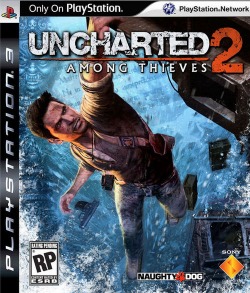
by Brian LeTendre
“Uncharted 2: Among Thieves” may just be the most well-crafted experience I’ve ever had in a video game. Equal parts “Indiana Jones,” Tomb Raider and “Half-Life 2,” it sets a new standard for storytelling in games as well as the seamless integration of story and gameplay.
“Uncharted 2” once again puts players in the shoes of treasure hunter Nathan Drake, who is hired to help a couple other hunters steal an artifact that may hold the key to finding Marco Polo’s lost fleet (and his lost treasure). Things get complicated however, and Drake finds out that Marco Polo may have found the legendary city of Shambala. Drake gets double-crossed, and learns that the man who originally hired him is trying to find Shambala and a mythical stone that will make him the most powerful man in the world. Drake reunites with an old friend to try and stop the madman before he can get the stone.
What’s truly amazing about “Uncharted 2” is the way developer Naughty Dog has combined every element to make something that’s much greater than the sum of its parts. While the third-person combat, platforming, puzzle-solving and stealth elements of the gameplay are all solid, it’s the way they are woven into the story that makes the experience so great. The gameplay transitions seamlessly out of the cutscenes, so you’re never taken out of the moment. The pacing is great, so just when you start to get your fill of combat, there’s a nice puzzle-solving segment to cleanse the palette. And the platforming segments offer you a chance to take in the gorgeous vistas and huge set pieces. All of those elements are combined with a story that rivals anything “Indiana Jones” has ever done.
While “Uncharted 2’s” story is excellent, it wouldn’t be nearly as good without the amazing voice acting and direction. Nolan North (Drake), Claudia Black (Chloe), Emily Rose (Elena Fisher) and Steve Valentine (Harry Flynn) lead a fantastic cast of voice actors that have really set a new standard for video games. Whether it’s witty banter, heated arguments or emotionally heavy scenes, the actors bring the characters to life in a way I haven’t seen before in a game. When Drake first runs into Elena again, you feel the history between the characters. You can also feel the tension between Elena and Chloe, the ‘new girl.’ The game is littered with laugh out loud moments, and Nolan North’s delivery in particular is spot on. I would love for Naughty Dog to create a series of animated movies based on this franchise, and I’ll be playing through the game again just to experience the story.
Accompanying the stellar single-player campaign in a very solid multiplayer component. You can customize your character by using money you earn through playing, and the platforming elements provide an extra layer of strategy to the standard multiplayer shooter formula. There's also co-op missions that take levels from the game and give you new objectives to accomplish in them with a buddy.
Every year the term “system-seller” is thrown around when it comes to console exclusives. “Uncharted 2: Among Thieves” is one of the few games deserving of that label. If you do not own a PS3, this game is a reason to buy one. It’s by far the best game I’ve played this year, and quite possibly the best of this console generation.
5 out of 5 Adventures of a Lifetime
“Uncharted 2: Among Thieves” may just be the most well-crafted experience I’ve ever had in a video game. Equal parts “Indiana Jones,” Tomb Raider and “Half-Life 2,” it sets a new standard for storytelling in games as well as the seamless integration of story and gameplay.
“Uncharted 2” once again puts players in the shoes of treasure hunter Nathan Drake, who is hired to help a couple other hunters steal an artifact that may hold the key to finding Marco Polo’s lost fleet (and his lost treasure). Things get complicated however, and Drake finds out that Marco Polo may have found the legendary city of Shambala. Drake gets double-crossed, and learns that the man who originally hired him is trying to find Shambala and a mythical stone that will make him the most powerful man in the world. Drake reunites with an old friend to try and stop the madman before he can get the stone.
What’s truly amazing about “Uncharted 2” is the way developer Naughty Dog has combined every element to make something that’s much greater than the sum of its parts. While the third-person combat, platforming, puzzle-solving and stealth elements of the gameplay are all solid, it’s the way they are woven into the story that makes the experience so great. The gameplay transitions seamlessly out of the cutscenes, so you’re never taken out of the moment. The pacing is great, so just when you start to get your fill of combat, there’s a nice puzzle-solving segment to cleanse the palette. And the platforming segments offer you a chance to take in the gorgeous vistas and huge set pieces. All of those elements are combined with a story that rivals anything “Indiana Jones” has ever done.
While “Uncharted 2’s” story is excellent, it wouldn’t be nearly as good without the amazing voice acting and direction. Nolan North (Drake), Claudia Black (Chloe), Emily Rose (Elena Fisher) and Steve Valentine (Harry Flynn) lead a fantastic cast of voice actors that have really set a new standard for video games. Whether it’s witty banter, heated arguments or emotionally heavy scenes, the actors bring the characters to life in a way I haven’t seen before in a game. When Drake first runs into Elena again, you feel the history between the characters. You can also feel the tension between Elena and Chloe, the ‘new girl.’ The game is littered with laugh out loud moments, and Nolan North’s delivery in particular is spot on. I would love for Naughty Dog to create a series of animated movies based on this franchise, and I’ll be playing through the game again just to experience the story.
Accompanying the stellar single-player campaign in a very solid multiplayer component. You can customize your character by using money you earn through playing, and the platforming elements provide an extra layer of strategy to the standard multiplayer shooter formula. There's also co-op missions that take levels from the game and give you new objectives to accomplish in them with a buddy.
Every year the term “system-seller” is thrown around when it comes to console exclusives. “Uncharted 2: Among Thieves” is one of the few games deserving of that label. If you do not own a PS3, this game is a reason to buy one. It’s by far the best game I’ve played this year, and quite possibly the best of this console generation.
5 out of 5 Adventures of a Lifetime
